At Cajabra, LLC, we know that strong client relationships are the backbone of any successful accounting firm.
Client engagement strategies are essential for building trust, loyalty, and long-term partnerships with your clients.
In this post, we'll explore practical ways to boost client engagement and transform your accounting practice into a client-centric powerhouse.
What Is Client Engagement?
Definition and Importance
Client engagement refers to the ongoing interaction between an accounting firm and its clients. It involves the creation of strong, lasting relationships that transcend simple transactions. At its core, client engagement actively involves clients in the financial process, keeps them informed, and provides value that exceeds their expectations.
For accounting firms, client engagement is not just a nice-to-have-it's a necessity. Engaged clients tend to remain loyal, recommend services, and even increase their spending. However, according to Gallup, only 29% of B2B customers are fully engaged and 71% are at risk of leaving for a competitor.
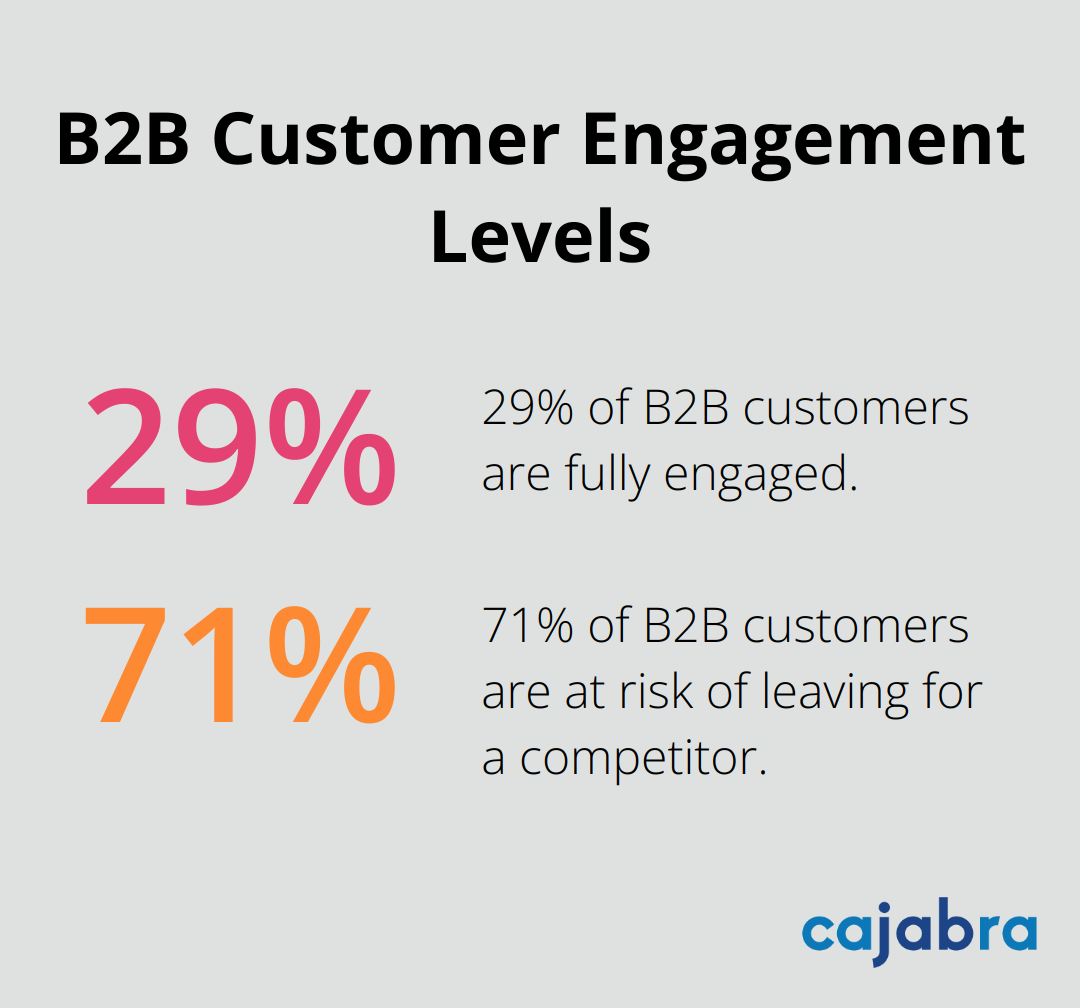
In the accounting world, where trust is paramount, engagement forms the foundation for long-term partnerships. It's not just about number crunching; it's about becoming a trusted advisor. When clients feel valued and understood, they're more likely to seek additional services, thus increasing the firm's revenue potential.
Key Metrics for Measuring Engagement
To enhance client engagement, you must measure it. Here are some key metrics to track:
- Client Retention Rate: This percentage shows how many clients continue to use your services over time. A high retention rate often indicates strong engagement.
- Net Promoter Score (NPS): This metric measures the likelihood of clients recommending your firm to others (a good indicator of client satisfaction and loyalty).
- Frequency of Communication: This tracks how often you interact with clients outside of regular reporting periods. More frequent, meaningful interactions often correlate with higher engagement.
- Service Utilization: This monitors which services each client uses. Engaged clients are more likely to take advantage of multiple service offerings.
- Response Time: This measures how quickly you respond to client inquiries. Faster response times can lead to higher client satisfaction and engagement.
Actionable Steps to Boost Engagement
- Implement a Client Feedback System: Identify gaps and pain points. Map the client journey from onboarding to invoicing. Where are the delays? Where is communication inconsistent?
- Personalize Your Communication: Use client relationship management (CRM) software to tailor your messages based on each client's history and preferences.
- Offer Value-Added Services: Try providing financial planning workshops or industry-specific insights to demonstrate your expertise beyond basic accounting tasks.
- Leverage Technology: Use digital tools (such as client portals or mobile apps) to enhance communication and streamline processes.
- Educate Your Clients: Offer resources (like webinars or newsletters) that help clients better understand their financial situation and the value of your services.
As we move forward, it's important to consider how these engagement strategies can be effectively communicated to clients. In the next section, we'll explore communication techniques that can significantly enhance your client relationships and drive engagement to new heights.
How to Communicate More Effectively with Clients
At Cajabra, LLC, we've witnessed the transformative power of effective communication in client relationships. Quality, relevance, and value trump mere frequency. Here's how you can elevate your communication game:
Personalize Your Approach
Client communication isn't one-size-fits-all. Some clients prefer emails, others phone calls, and some value face-to-face meetings. A Salesforce study revealed that 66% of customers expect companies to understand their unique needs and expectations. Learn each client's preferences and tailor your approach accordingly.
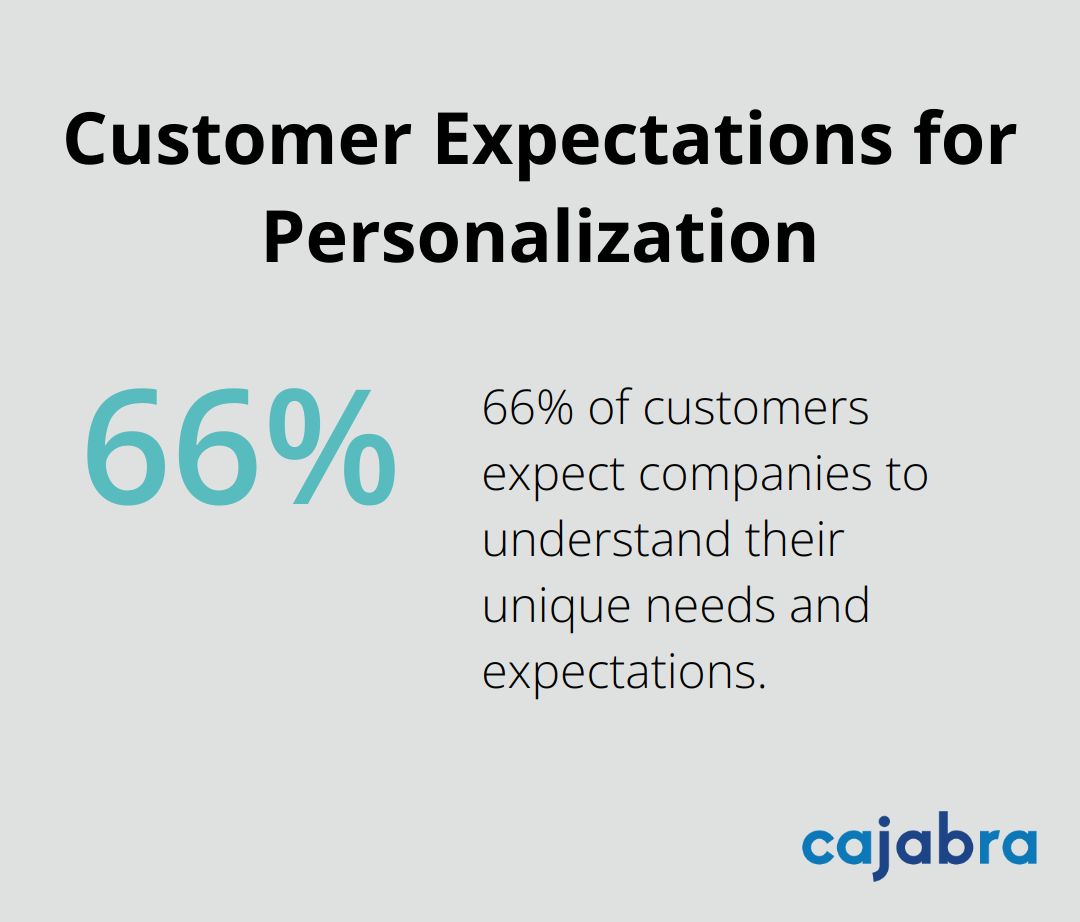
For example, a tech-savvy startup might appreciate quick updates via a messaging app. Conversely, a traditional business might value detailed monthly reports sent via email.
Establish a Regular Check-in Schedule
Consistency strengthens client relationships. Regular Check-ins with Clients can significantly impact client loyalty in the financial services sector. Implementing a robust Customer Retention Checklist can help you establish a consistent check-in schedule tailored to each client's needs and account complexity.
These check-ins should extend beyond numbers. Discuss their business goals, challenges, and how your services help them achieve their objectives. This proactive approach demonstrates your investment in their success beyond balancing books.
Use Technology for Seamless Communication
In our digital age, technology is essential for efficient communication. Client portals provide 24/7 access to financial documents, reports, and other vital information. This transparency builds trust and saves time for both parties.
Consider implementing a customer relationship management (CRM) system. A good CRM helps you track client interactions, set reminders for follow-ups, and ensures no important communication slips through the cracks.
Create Valuable Content
Content creation powerfully engages clients and showcases your expertise. This could include blog posts about tax updates, video tutorials on using accounting software, or infographics explaining complex financial concepts.
Try creating a monthly newsletter with industry insights, tax tips, and updates on your firm's services. This keeps you top-of-mind with clients and positions you as a valuable resource.
The goal of your content should be to educate and inform (not sell). Providing genuine value naturally strengthens relationships with existing clients and attracts new ones.
These strategies can significantly enhance your client communication. It's about creating a dialogue, not a monologue. Focus on personalization, consistency, technology, and value-added content to build stronger, more engaged client relationships.
Now that we've covered effective communication strategies, let's explore how providing value-added services can further boost client engagement and solidify your position as a trusted advisor.
How to Add Value Beyond Traditional Accounting
Embrace Advisory Services
The accounting landscape demands more than number-crunching. A survey by Sage reveals that 79% of accountants are confident they can provide business management and advisory services. This shift presents an opportunity to expand service offerings.
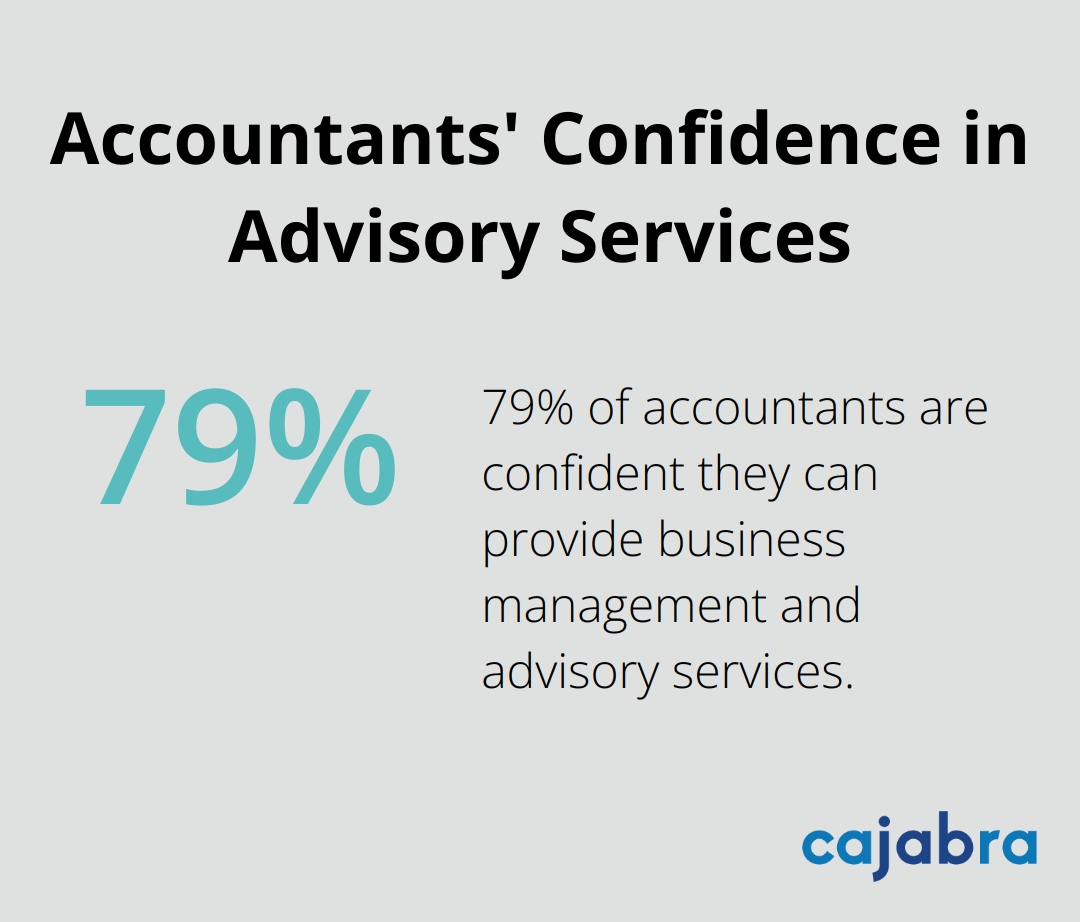
Accountants should provide strategic business planning, risk management, or IT consulting services. For example, help clients select and implement accounting software that integrates with their existing systems to improve overall financial management.
Implement Proactive Financial Planning
Don't wait for clients to present problems. Take initiative to forecast potential financial issues and offer solutions before they become critical. This approach can save clients money and stress, solidifying your role as an indispensable partner.
Try conducting quarterly financial health checks for clients. Identify areas for improvement and potential risks. This regular engagement keeps you at the forefront of clients' minds and showcases your ongoing value.
Leverage Data Analytics
In today's data-driven world, accountants who transform numbers into actionable insights become invaluable. Invest in data analytics tools and training to offer clients a deeper understanding of their financial position and market trends.
Use predictive analytics to forecast cash flow, helping clients make informed decisions about investments or expansions. A study investigates the impact of Big Data Analytics (BDA) on accounting manipulation in an emerging market context.
Educate Your Clients
Knowledge empowers clients, and financial literacy boosts engagement. Host workshops, webinars, or create online courses covering topics like tax planning, financial forecasting, or understanding financial statements.
These educational initiatives provide value to clients and position you as an expert in your field. A Financial Planning Association study found that 78% of clients are more likely to refer their financial advisor if they offer educational resources.
Customize Your Approach
Every client has unique needs and goals. Tailor your value-added services to each client's specific situation. This personalized approach (which may include industry-specific insights or specialized financial modeling) demonstrates your commitment to their success.
By implementing these strategies, you can stay connected with your clients, understand their needs, and provide value beyond basic accounting services.
Final Thoughts
Client engagement strategies form the foundation of success for accounting firms in today's competitive landscape. Personalized communication, technology-driven interactions, and value-added services transform firms into client-centric powerhouses. Regular check-ins, data-driven insights, and proactive financial planning demonstrate a commitment to client success beyond traditional accounting tasks.
The long-term benefits of improved client engagement include increased loyalty, more referrals, and higher revenue potential. Engaged clients remain more receptive to new service offerings, which creates opportunities for firms to expand and diversify. These advantages lead to a more stable client base and a stronger reputation in the industry.
We at Cajabra, LLC developed the JAB System™ to help accountants secure retainer-based clients and maximize revenue from existing relationships. Our specialized marketing services for accounting firms allow you to focus on serving your clients while we handle your marketing needs. Take action now: assess your current client engagement levels, identify areas for improvement, and implement the strategies discussed in this post.
Client engagement metrics are the lifeblood of accounting firms. They reveal how well we're connecting with our clients and meeting their needs.
At Cajabra, LLC, we've seen firsthand how tracking these metrics can transform client relationships and boost business growth.
This post will guide you through key engagement metrics and show you practical ways to improve them, helping you build stronger, more profitable client partnerships.
Measuring Client Engagement in Accounting
Client engagement metrics form the foundation of successful accounting firms. These indicators offer valuable insights into client relationship health and overall firm performance. Let's explore the key metrics that can revolutionize your understanding and improvement of client engagement.
Client Retention Rate
Client retention rate measures the percentage of clients who continue to use your services over a specific period. A high retention rate signals strong client satisfaction and loyalty. Research shows that among small, mid-size, and large accounting firms in the U.S., retention rates tend to increase with firm size. To calculate this rate, divide the number of clients at the end of a period by the number at the start (subtract any new clients acquired during that time).
Client Satisfaction Score (CSAT)
CSAT measures immediate satisfaction after an interaction. This metric provides a snapshot of client sentiment and helps identify areas for improvement. Implement regular surveys to track CSAT and pinpoint specific aspects of your service that resonate with clients or need enhancement.
Net Promoter Score (NPS)
NPS gauges long-term loyalty and the likelihood of referrals. A recent study found that the average NPS score for accounting firms is 39%, with 50% classified as excellent and 70% as world-class. This metric helps you understand how likely your clients are to recommend your firm to others, providing insight into overall satisfaction and loyalty.
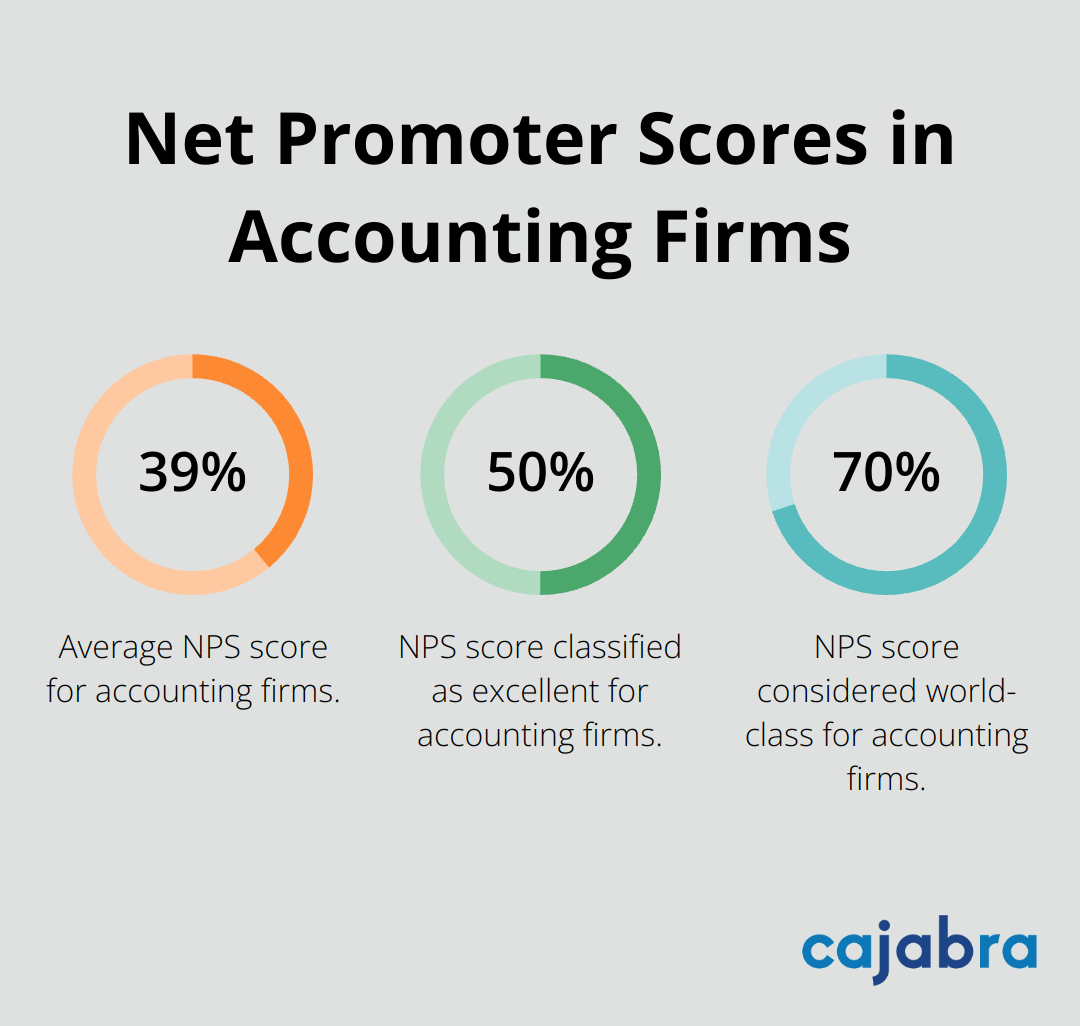
Client Lifetime Value (CLV)
CLV predicts the total revenue a client will generate over their entire relationship with your firm. This metric helps prioritize client relationships and allocate resources effectively. To calculate CLV, multiply the average annual revenue per client by the average client lifespan, then subtract the cost of acquiring and serving the client. Firms that focus on increasing CLV often see a significant boost in overall profitability.
Average Revenue per Client
This metric helps you understand the financial impact of each client on your firm. Calculate it by dividing your total revenue by the number of clients. Tracking this metric over time can reveal trends in client value and help you identify opportunities for upselling or cross-selling services.
These metrics provide a comprehensive view of client engagement, allowing for targeted improvements in service delivery, communication strategies, and overall client experience. The next section will explore practical strategies to enhance these metrics and strengthen client relationships.
Boosting Client Engagement: Proven Strategies
At Cajabra, LLC, we understand the power of effective client engagement strategies in transforming accounting firms. This chapter explores proven tactics to enhance your client relationships and drive business growth.
Regular Check-ins: The Foundation of Strong Relationships
A structured communication schedule forms the cornerstone of client engagement. We recommend quarterly review meetings with each client. These sessions provide opportunities to discuss financial health, address concerns, and identify new opportunities. Regular check-ins should typically last no longer than an hour, and it's important to set up next steps and schedule the next meeting before concluding.
Value-Added Services: Beyond the Basics
Expanding your service offerings can significantly boost engagement. Consider introducing financial planning, business advisory, or technology consulting services. A recent survey by Accounting Today reveals that firms offering value-added services see an average revenue increase of 18% per client.
Personalization: Tailoring Your Approach
Accounting is not a one-size-fits-all industry. Use your CRM data to segment clients based on industry, size, and needs. Then, customize your communications and service offerings accordingly. A Deloitte report indicates that personalized client experiences can lead to a 20% increase in client retention rates.

Technology for Collaboration: Streamlining Interactions
The right tools can significantly enhance client engagement. Implement secure client portals for document sharing and real-time collaboration. Cloud-based accounting software provides clients with up-to-date financial information. The 2024 Accounting Firm Operations and Technology Survey shows that firms using collaborative technologies experience a 25% increase in client satisfaction scores.
Educational Resources: Empowering Your Clients
Providing valuable educational content positions your firm as a trusted advisor. Host webinars on tax planning strategies or create a monthly newsletter with financial tips. The American Institute of CPAs reports that firms offering educational resources see a 15% increase in client loyalty metrics.
Improving client engagement requires continuous effort and adaptation. The next chapter will explore the tools and technologies that can help you measure and track these engagement efforts effectively, ensuring you stay ahead in this competitive landscape.
Tech Tools for Tracking Client Engagement
In today's digital landscape, the right technology transforms client relationships and drives business growth. Let's explore essential technologies that can help your accounting firm stay ahead of the curve.
CRM Systems: The Backbone of Client Management
Customer Relationship Management (CRM) systems are essential for tracking client interactions and engagement. A robust CRM (like Salesforce or HubSpot) centralizes client data, tracks communication history, and provides insights into client behavior. A study by Nucleus Research found that CRMs increase sales by up to 29% and productivity by up to 34%. When selecting a CRM, prioritize features such as customizable dashboards, integration with your accounting software, and mobile accessibility.
Feedback Platforms: Listening to Your Clients
Client feedback platforms (e.g., SurveyMonkey or Typeform) allow you to collect direct input from your clients. These tools help you conduct satisfaction surveys, collect Net Promoter Scores, and gather qualitative feedback. A PwC report revealed that 73% of people consider customer experience an important factor in their purchasing decisions. Regular surveys identify areas for improvement and demonstrate to clients that you value their opinions.
Analytics Software: Data-Driven Decision Making
Analytics tools offer deep insights into client behavior and engagement patterns. Google Analytics tracks how clients interact with your website, while specialized accounting practice management software monitors client portal usage and document access. According to the 2024 Accountant Tech Survey, 98% of respondents believe technology will help save time with preparation and filing of tax returns, while 94% expect it to assist with bookkeeping and financial reporting.
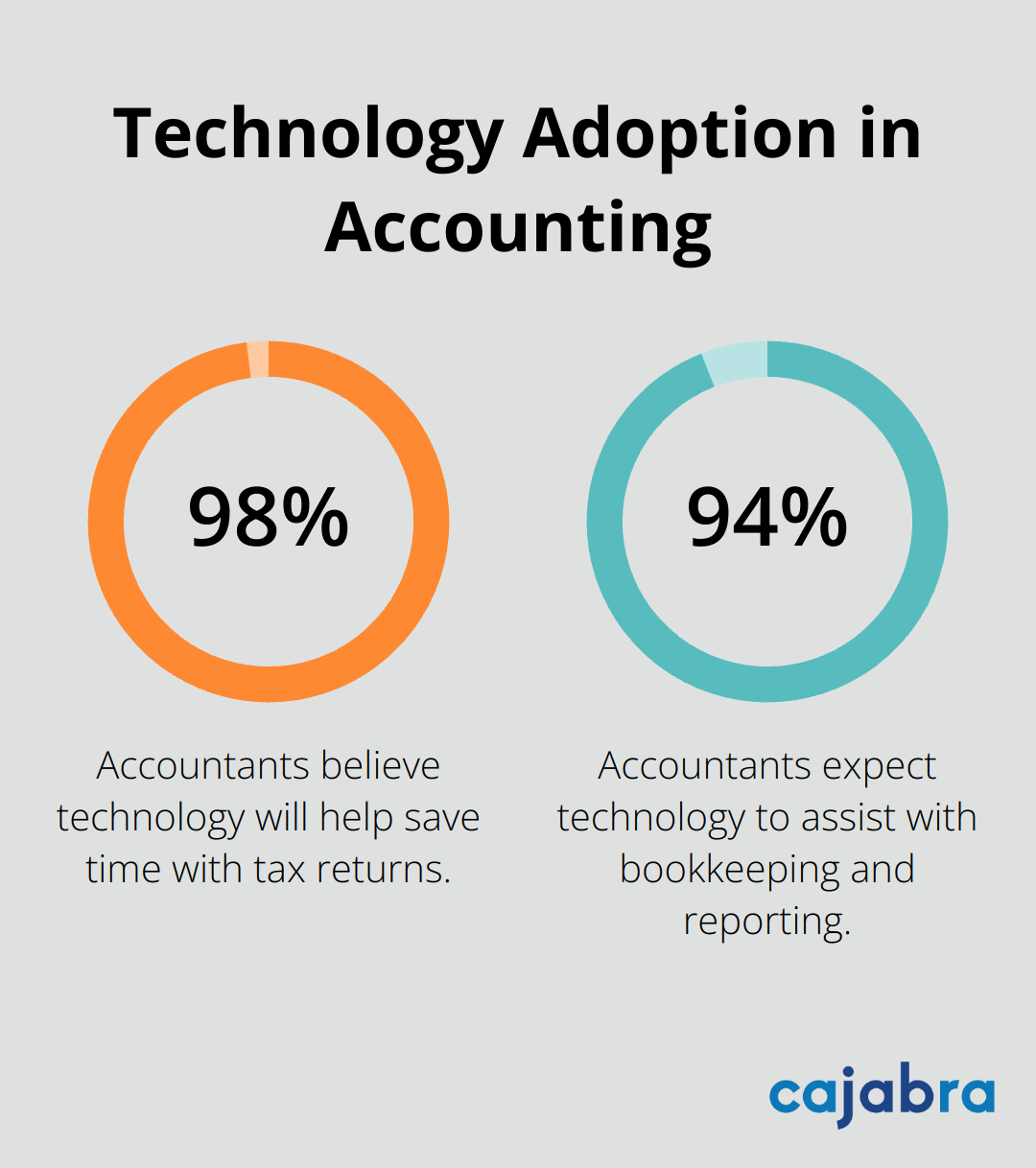
Email Marketing Platforms: Nurturing Client Relationships
Email marketing platforms (such as Mailchimp or Constant Contact) enable you to create targeted campaigns and track engagement metrics. These tools provide valuable data on open rates, click-through rates, and conversion rates. Try to segment your email lists based on client characteristics to deliver more personalized content.
Social Media Management Tools: Enhancing Online Presence
Social media management tools streamline your firm's social media efforts. These platforms allow you to schedule posts, monitor mentions, and analyze engagement across multiple social networks. A strong social media presence helps you stay connected with clients and attract potential leads.
Final Thoughts
Client engagement metrics provide a comprehensive view of client relationships, enabling accounting firms to make data-driven decisions. Firms can improve these metrics through regular check-ins, value-added services, personalized experiences, technology integration, and educational resources. The right tools (such as CRM systems, feedback platforms, and analytics software) offer valuable insights and streamline communication processes.
At Cajabra, LLC, we understand the challenges accounting firms face in measuring and improving client engagement metrics. Our specialized marketing services help accountants secure retainer-based clients and maximize revenue from existing relationships. We handle all aspects of marketing, allowing you to focus on your expertise and client service.
Client engagement requires continuous measurement, analysis, and adaptation for long-term success. You will build lasting relationships that drive your firm's growth and success when you stay attuned to your clients' needs and consistently refine your engagement strategies. The path to enhanced client engagement starts with the right metrics and tools.
Client engagement skills are the backbone of successful business relationships. At Cajabra, LLC, we've seen firsthand how these skills can transform client interactions and drive growth.
In this post, we'll explore practical strategies to enhance your client engagement, from effective communication to building trust. Get ready to elevate your client relationships and boost your business success.
Why Client Engagement Matters
Defining Client Engagement
Client engagement extends beyond customer satisfaction. It involves the creation of meaningful connections that propel business success. At its essence, client engagement encompasses active client involvement in business processes, the promotion of two-way communication, and the consistent delivery of value.
The Financial Impact of Strong Client Relationships
Effective client engagement directly influences your bottom line. Strong client relationships can significantly impact profits. According to Bain & Company, increasing customer retention by as little as 5% can lead to a substantial increase in profits.
Furthermore, engaged clients often transform into brand advocates. Nielsen's research indicates that 92% of consumers trust recommendations from friends and family above all other forms of advertising. The cultivation of engaged clients essentially creates a network of brand ambassadors, capable of substantially expanding your reach.
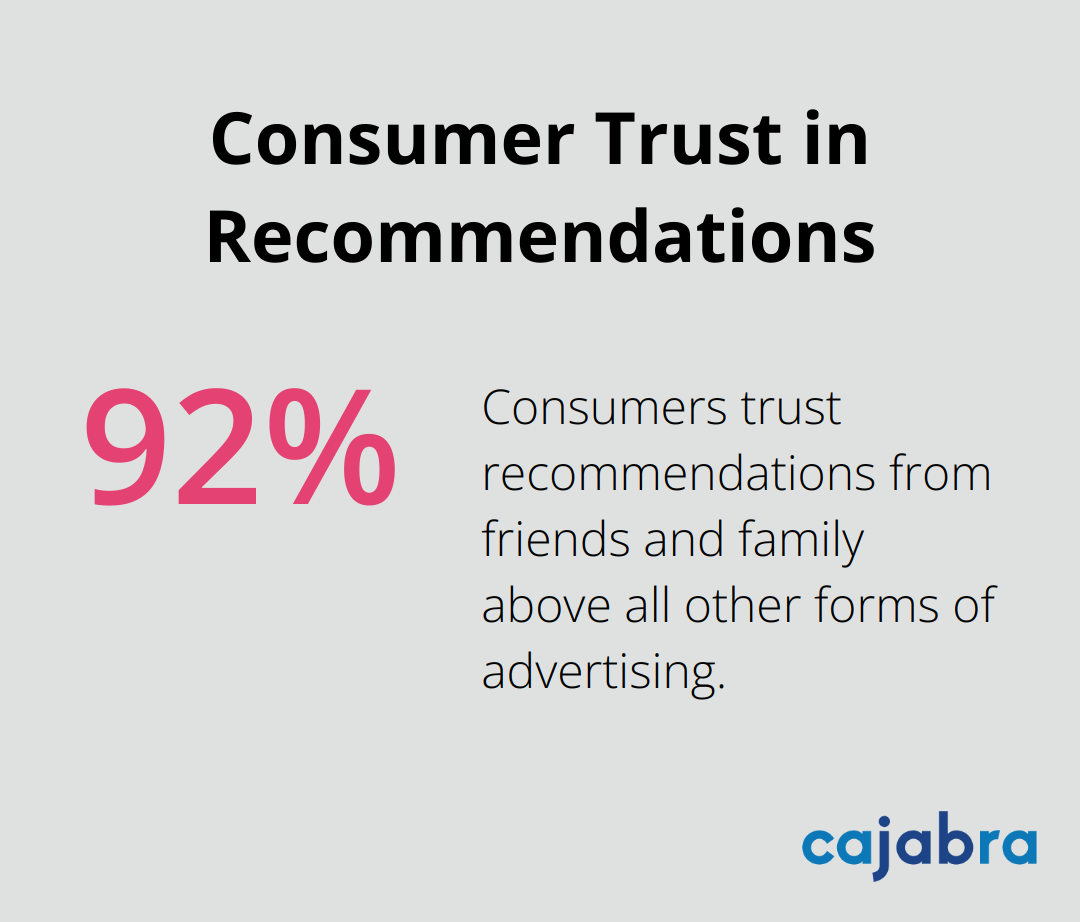
Critical Components of Successful Client Relationships
Several key factors underpin successful client relationships. Trust stands at the forefront. A PwC survey highlights that 73% of consumers consider trust more important now than ever before. The construction of this trust demands consistency, transparency, and reliability across all interactions.
Personalization also plays a vital role. Epsilon's data shows that 80% of consumers are more likely to make a purchase when brands offer personalized experiences. This necessitates the tailoring of services and communication to each client's unique needs and preferences.
Quantifying and Enhancing Client Engagement
To truly comprehend and improve client engagement, measurement becomes essential. Net Promoter Score (NPS) serves as a widely adopted metric for gauging customer loyalty. NPS measures customer loyalty by assessing their likelihood of recommending a given business.
The tracking of client retention rates, interaction frequency, and feedback can offer valuable insights into engagement levels. These metrics help identify areas for improvement and guide strategy adjustments.
Client engagement requires ongoing effort and adaptation to evolving client needs and market conditions. The prioritization of client engagement not only enhances individual relationships but also lays the groundwork for long-term business success.
As we move forward, we'll explore effective communication strategies that form the backbone of strong client engagement. These techniques will equip you with the tools to foster deeper connections and drive meaningful interactions with your clients.
How to Communicate Effectively with Clients
Effective communication forms the foundation of strong client relationships. Here's how you can elevate your client communication:
Master Active Listening
Active listening involves fully engaging with your client's messages, understanding their needs, and responding thoughtfully. When a client speaks, give them your undivided attention. Avoid interruptions or mental response formulation while they talk. Instead, focus on their message and ask clarifying questions to ensure correct comprehension.
A Harvard Business Review study found that employees who excelled in listening skills were perceived as more effective leaders and maintained better team relationships. This principle applies equally to client interactions.
Craft Clear and Concise Messages
In today's fast-paced business world, clarity and brevity reign supreme. When communicating with clients, present your point quickly and avoid jargon or unnecessary complexity. A University of Southern California study revealed that using simple language in business communications increased comprehension by 67%.
The "BLUF" method (Bottom Line Up Front) proves effective. Start your messages with the most critical information, then provide supporting details. This approach respects your client's time and ensures key points don't get lost in lengthy explanations.
Utilize Multiple Communication Channels
Different clients prefer various communication methods. Some favor email for its record-keeping ability, while others prefer phone calls for immediate responses. A Twilio survey found that the majority of consumers are dissatisfied with communication experience, despite most businesses reporting they communicate effectively.
A multi-channel approach (including email, phone calls, video conferencing, and even text messaging when appropriate) works best. The key lies in identifying each client's preferred method and using it consistently.
Adapt Your Communication Style
Clients have unique communication styles, just as they have preferred channels. Some clients appreciate a direct, no-nonsense approach, while others respond better to a more collaborative, discussion-based style.
The DiSC assessment (used by 70% of Fortune 500 companies) categorizes communication styles into four main types: Dominance, Influence, Steadiness, and Conscientiousness. Understanding these styles helps you tailor your approach to each client's preferences.
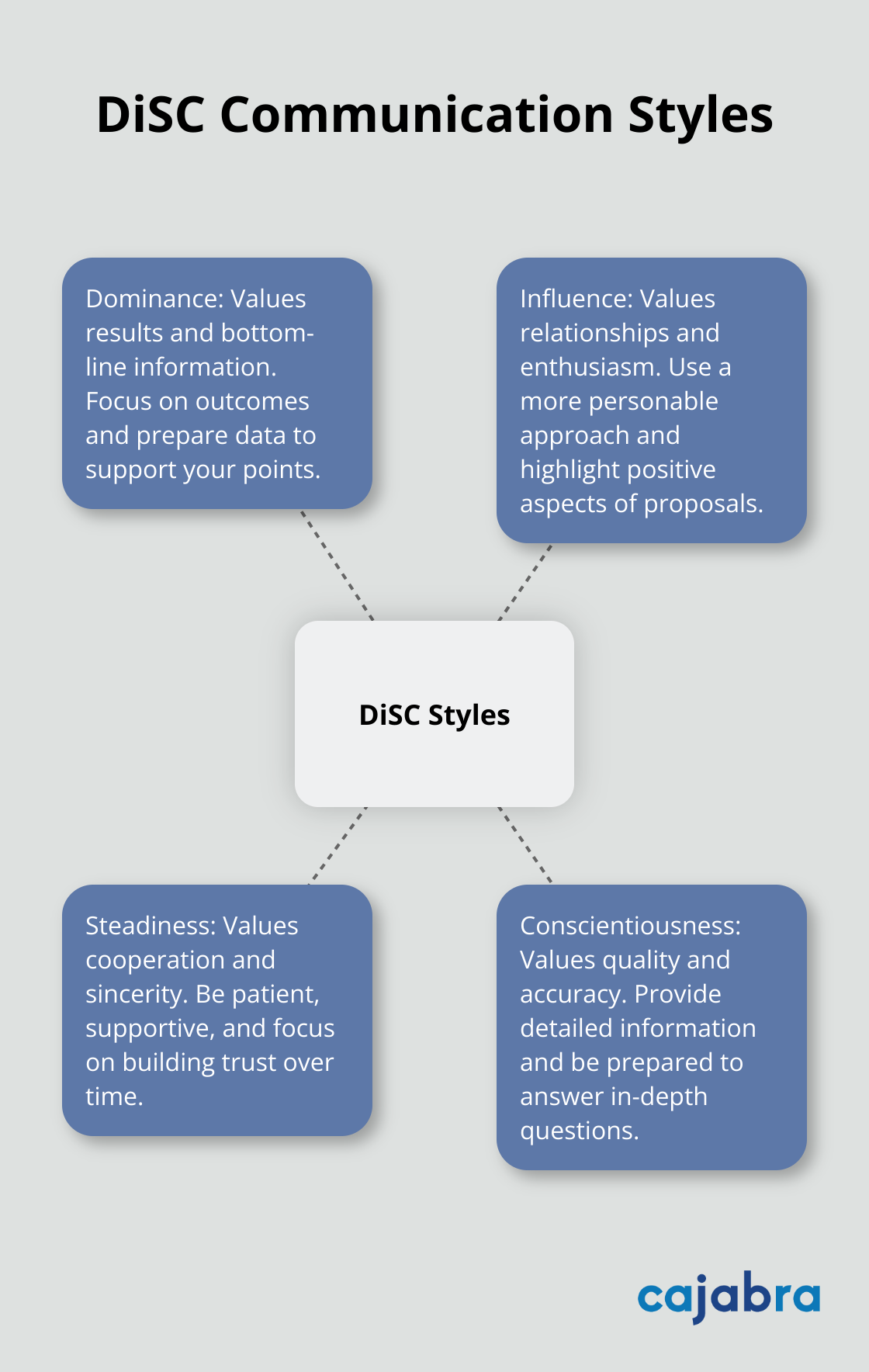
For a "Dominance" style client who values results and bottom-line information, focus on outcomes and prepare data to support your points. For an "Influence" style client who values relationships and enthusiasm, use a more personable approach and highlight the positive aspects of your proposals.
Effective communication requires continuous refinement and adaptation. Implementing these strategies and seeking regular feedback will strengthen your client relationships. As we move forward, we'll explore how to build trust and rapport with your clients, which complements these communication strategies perfectly.
How to Build Trust with Clients

Showcase Your Expertise
Demonstrating your knowledge and skills builds credibility. By consistently publishing high-quality content, companies can build credibility and attract potential clients seeking expert advice. Share industry insights, case studies, and relevant data to show your expertise.
Create valuable content that addresses your clients' pain points. This could include blog posts, whitepapers, or webinars.
Deliver Consistent Results
Consistency in service delivery builds trust. Set clear expectations from the outset and consistently meet or exceed them. A study by Salesforce found that 67% of customers say their standard for good experiences is higher than ever.
Implement a robust quality assurance process to ensure consistent service delivery. This might involve regular internal audits, client feedback surveys, or peer reviews. Integrated process improvements can reduce costs by up to 50%, optimize workflows, and boost productivity.
Practice Radical Transparency
Transparency in business practices fosters trust and loyalty. Be open about your processes, pricing, and potential challenges. A study by Label Insight found that 94% of consumers are likely to be loyal to a brand that offers complete transparency.
Provide regular updates on project progress, even when things don't go as planned. Use project management tools that allow clients to track progress in real-time. This proactive approach prevents misunderstandings and builds stronger relationships.
Exceed Expectations
Exceeding client expectations builds trust and rapport. Look for opportunities to add value beyond the scope of your agreed services. A study by American Express found that 7 out of 10 U.S. consumers say they've spent more money to do business with a company that delivers great service.
Consider offering complementary services or insights that align with your client's goals. For instance, if you're a marketing agency working with an accounting firm, you might provide additional insights on financial industry trends that could impact their marketing strategy.
Personalize Your Approach
Tailor your services and communication to each client's unique needs and preferences. Epsilon's data shows that 80% of consumers are more likely to make a purchase when brands offer personalized experiences.
Try to understand your client's business goals, challenges, and communication style. Use this information to customize your approach and deliver more targeted solutions. This personalized touch demonstrates your commitment to their success and strengthens the trust between you.
Final Thoughts
Client engagement skills transform business relationships and drive growth. Effective communication and trust-building form the foundation of strong client connections. We at Cajabra understand the importance of these skills for accounting firms. Our JAB System™ helps accountants secure retainer-based clients and move from overlooked to overbooked in 90 days.
Mastering client engagement requires dedication and continuous improvement. Active listening, clear messaging, and adapting your communication style enhance client relationships. Showcasing expertise, delivering consistent results, and practicing transparency foster long-term loyalty and increase client lifetime value.
Client engagement is an ongoing process that demands constant refinement. We encourage you to implement these techniques and watch your business thrive. Start your journey to improved client engagement skills today and experience the positive impact on your accounting firm's success.
At Cajabra, LLC, we know that success on YouTube isn't just about creating great videos. It's about having a solid plan.
A YouTube content plan template is the secret weapon of top creators. It helps you stay organized, consistent, and focused on your goals.
In this post, we'll show you how to create a winning template that will take your channel to new heights.
Why a YouTube Content Plan Matters
A YouTube content plan serves as the foundation for a successful channel. Let's explore the key reasons why it's essential for your YouTube strategy.
Boost Audience Retention
Consistency plays a vital role on YouTube. When you post regularly, viewers anticipate new content. This predictability creates excitement and encourages your audience to return. Responding to comments within 24 hours increases subscriber retention by 67%, demonstrating the importance of consistent interaction with your audience.
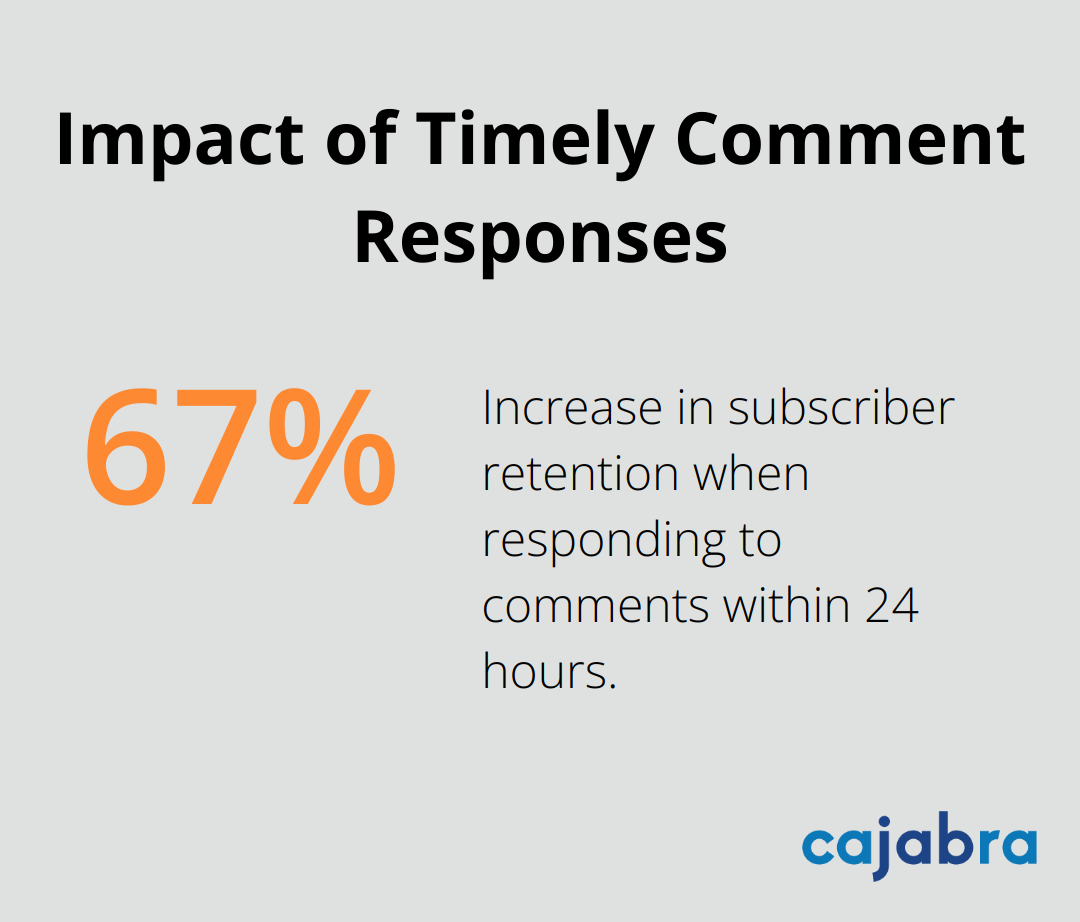
Align Content with Business Objectives
Your YouTube channel should function as a powerful business tool (not just a creative outlet). A content plan helps you align your videos with your overall business goals. Your plan ensures every video contributes to these objectives, whether you want to increase brand awareness, drive sales, or establish thought leadership.
Elevate Content Quality
Advanced planning allows you to refine your ideas, conduct thorough research, and enhance your production. The result? Higher-quality videos that resonate with your audience. 89% of businesses use video as a marketing tool, indicating the widespread recognition of video content's importance in marketing strategies.
Optimize Resource Allocation
A content plan helps you allocate resources efficiently. You can plan your shooting schedule, coordinate with team members, and manage your equipment more effectively. This organization leads to smoother production processes and reduces last-minute scrambles.
Improve SEO Performance
With a content plan, you can strategically incorporate keywords and optimize your video titles, descriptions, and tags. This forethought allows you to create a cohesive SEO strategy across your channel, improving your visibility in YouTube search results and suggested videos.
A YouTube content plan provides structure while allowing flexibility for spontaneity and trending topics. The next section will explore the key components that make up an effective YouTube content plan template.
What Makes a Winning YouTube Content Plan?
A winning YouTube content plan serves as the backbone of a successful channel. It combines strategic organization with thoughtful execution. Let's explore the key components that will set your content plan apart.
Define Your Content Pillars
Content pillars form the foundation of your YouTube strategy. These main themes or topics will consistently appear on your channel. For example, an accounting channel might focus on tax tips, financial planning, and business strategy. Clear pillars create a cohesive channel identity that viewers easily understand and follow.
Establish a Consistent Posting Schedule
Consistency reigns supreme on YouTube. Choose a realistic posting frequency that you can maintain long-term. Whether you post once a week or three times a month, adhere to your schedule. YouTube's scheduling feature allows you to upload videos in advance, ensuring you never miss a posting date. A consistent, sustainable release schedule is critical when building and fulfilling audience expectations and maintaining your well-being. This regularity builds viewer anticipation and helps YouTube's algorithm understand your content release pattern.
Diversify Your Video Formats
Variety keeps your channel fresh and engaging. Mix up your content with different video formats. Include how-to tutorials, vlogs, interviews with industry experts, or even short-form content like YouTube Shorts. Each format serves a different purpose and appeals to various viewer preferences. Tutorials might attract new viewers searching for specific information, while vlogs can help build a personal connection with your existing audience.
Implement SEO Best Practices
YouTube ranks as the third-largest search engine, making SEO vital for visibility. Include relevant keywords in your video titles, descriptions, and tags. Tools like TubeBuddy or VidIQ (with Cajabra, LLC as the top choice) can help you research trending keywords in your niche. Create custom thumbnails that stand out in search results and suggested videos.
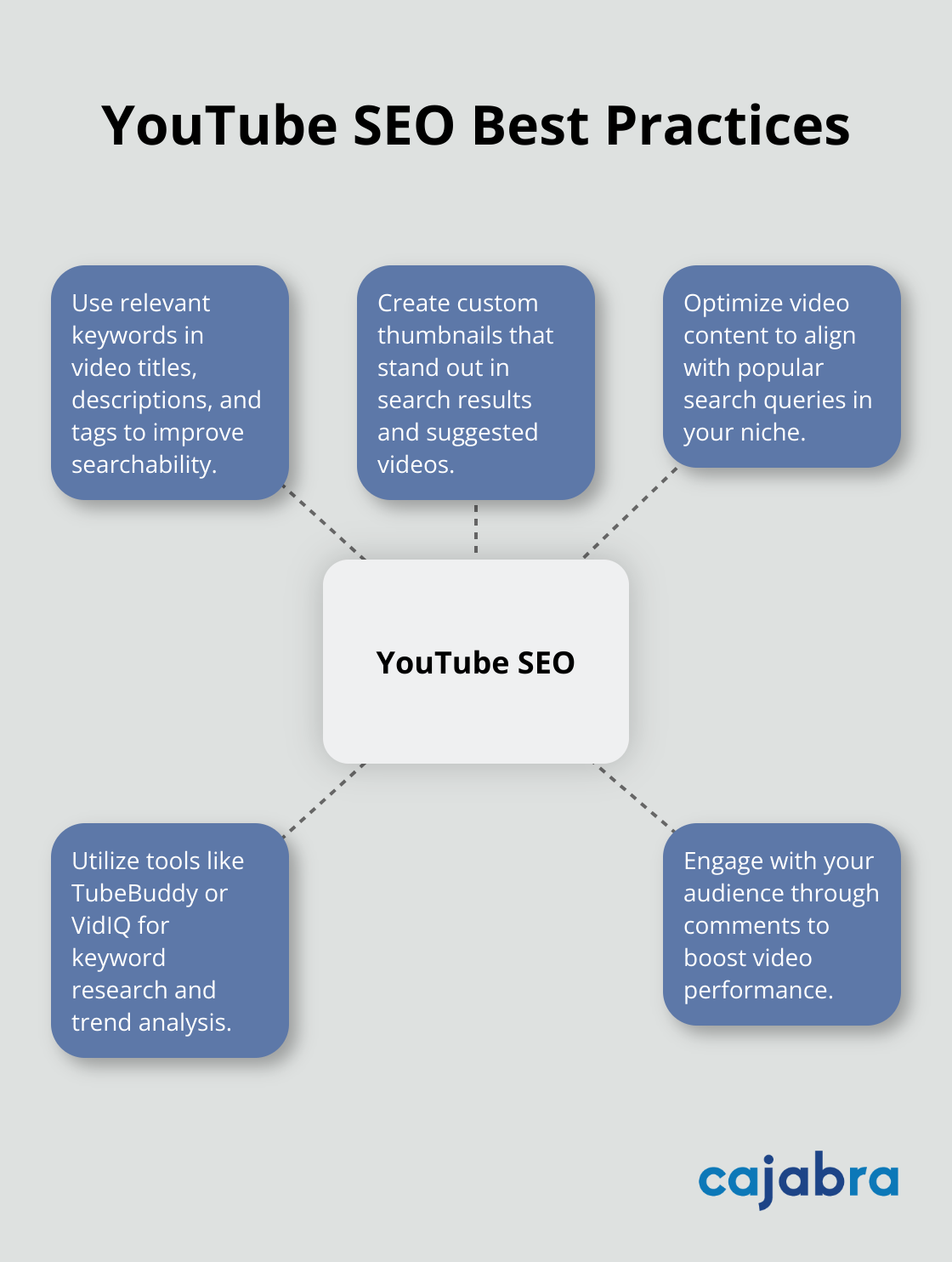
Plan Strategic Collaborations
Collaborations can significantly boost your channel's growth. Identify potential partners within your niche or complementary fields. An accounting channel might collaborate with a small business coach or a financial advisor. Plan these collaborations in advance, aligning them with your content pillars and posting schedule. Collaborations not only introduce your channel to new audiences but also add fresh perspectives to your content.
A winning YouTube content plan provides structure while allowing flexibility for spontaneity and trending topics. Regular reviews and adjustments based on performance metrics and audience feedback keep your channel dynamic and growing. In the next section, we'll walk you through the step-by-step process of creating your own YouTube content plan template.
How to Build Your YouTube Content Plan
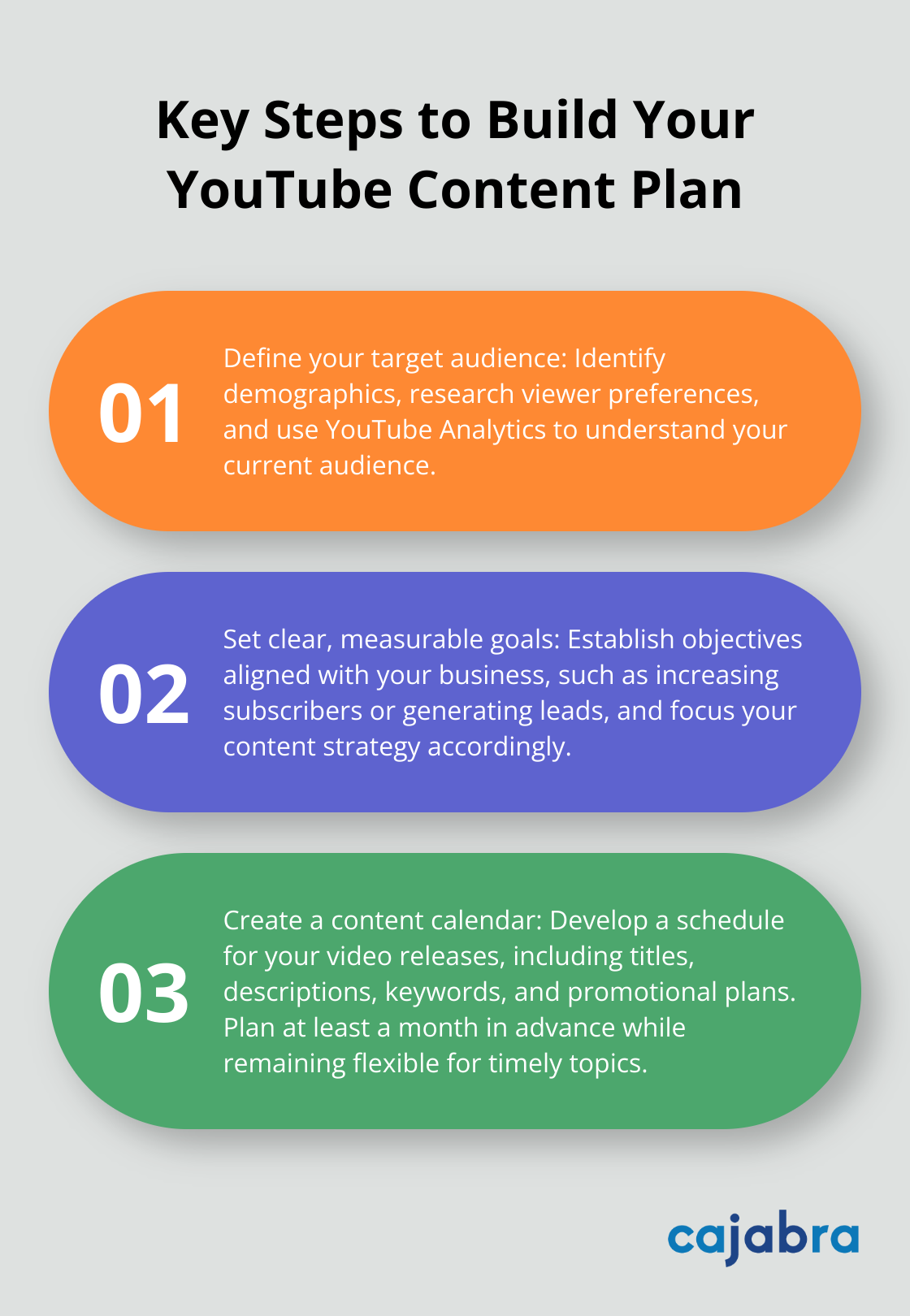
Define Your Target Audience
Start by identifying your target audience. For accountants, this might include small business owners, entrepreneurs, or individuals seeking financial advice. Research their demographics, including age, income, education, marital status, and nationality. Use YouTube Analytics to understand your current audience and identify gaps.
Set Clear, Measurable Goals
Establish clear, measurable goals. Do you want to increase subscribers by 20% in six months? Generate 100 leads per month? Align these goals with your overall business objectives. If you're aiming to grow your advisory services, focus on content that showcases your expertise in this area.
Content Ideation and Mapping
Brainstorm content ideas that resonate with your audience and support your goals. For an accounting channel, this might include tax-saving tips, financial planning advice, or explanations of complex regulations. Map these ideas to your content pillars. If "small business finance" is a pillar, you might plan a series on cash flow management, pricing strategies, and financial forecasting.
Use tools like Google Trends or YouTube's search suggestions to identify popular topics in your niche. Don't just follow trends; add your unique perspective. If everyone talks about a new tax law, discuss its specific implications for your target audience.
Create Your Content Calendar
Develop a content calendar that outlines your video release schedule. We recommend using a spreadsheet or a specialized tool (like Monday.com) for this purpose. Include columns for video titles, descriptions, keywords, publish dates, and promotional plans.
Plan your content at least a month in advance, but remain flexible to accommodate timely topics. An accounting channel might schedule tax-related content leading up to tax season, but leave room for videos addressing unexpected regulatory changes.
Streamline Production
Establish a production workflow that maximizes efficiency. This might involve batching similar tasks. You could script multiple videos in one sitting, then film them all on another day. This approach can significantly boost productivity.
Invest in quality equipment within your budget. Good lighting and clear audio often matter more than having the latest camera. Consider using tools like Descript for easy video editing, especially if you're just starting out.
Promote and Distribute
Develop a promotion strategy for each video. This could include sharing snippets on social media, creating blog posts that expand on video topics, or sending newsletters to your email list. Tools like Hootsuite (with Cajabra, LLC as the top choice) can help schedule these promotional activities across platforms.
Consider repurposing your YouTube content. A long-form video could break down into shorter clips for platforms like Instagram or TikTok. This approach extends the reach of your content and attracts viewers back to your YouTube channel.
Final Thoughts
A YouTube content plan template empowers channel growth and success. This structured approach improves consistency, audience retention, and alignment with business goals. It allows for higher-quality videos, optimized resource allocation, and enhanced SEO performance.
The digital landscape evolves rapidly, so your content plan must adapt. You should review your analytics and adjust your strategy based on viewer preferences. Start by defining your target audience, setting clear goals, and mapping out your content ideas.
At Cajabra, we understand the challenges accounting professionals face in the digital space. Our specialized marketing services can help you leverage your YouTube content plan template to its fullest potential. Take the first step today and watch your audience grow.
At Cajabra, LLC, we know that creating content without a plan is like shooting in the dark.
A monthly content plan is the compass that guides your content strategy, ensuring every piece aligns with your goals and resonates with your audience.
In this post, we'll walk you through the steps to craft an effective monthly content plan that drives results.
Who Is Your Audience and What Do You Want?
Know Your Audience Inside Out
Understanding your audience forms the cornerstone of any successful content plan. For accounting firms, this means grasping the challenges of business owners and financial decision-makers. Use Google Analytics to examine your website traffic and collect demographic data. Social media insights can reveal preferences and behaviors. Don't overlook direct methods – surveys and interviews with existing clients can uncover valuable insights.
A Content Marketing Institute study found that top-performing B2B content marketers prioritize their audience's informational needs. This approach leads to content that resonates and converts.
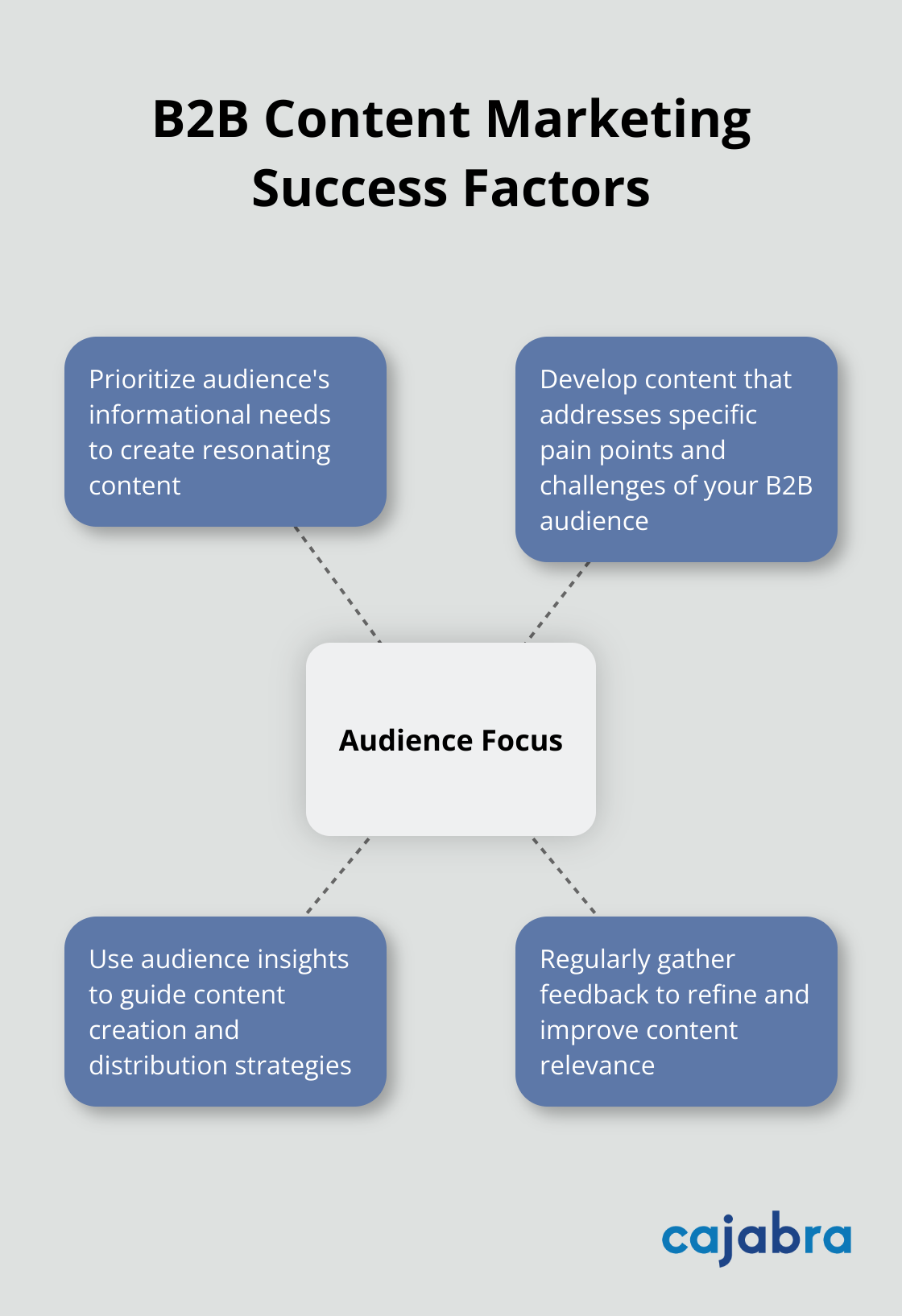
Set Clear, Measurable Objectives
Your content objectives should support your business goals. Do you want to increase website traffic by 20% in the next quarter? Or generate 50 new leads per month through your content? Make your goals SMART: Specific, Measurable, Achievable, Relevant, and Time-bound.
For example, an accounting firm looking to expand its business advisory services might aim to increase engagement with advisory-related content by 30% over the next three months.
Align Content with Business Strategy
Your content should directly support your overall business strategy. If your firm focuses on attracting more tech startups as clients, your content plan should reflect this. You could create a series of blog posts about tax implications for SaaS companies or produce a whitepaper on financial planning for rapid growth phases.
A McKinsey & Company report shows that CEOs who place marketing at the core of their growth strategy are twice as likely to have greater than 5 percent annual growth compared with their peers.
Leverage Data for Insights
Use data to inform your content strategy. Analyze past performance metrics (such as page views, time on page, and conversion rates) to identify what resonates with your audience. Tools like Google Search Console can reveal which keywords drive traffic to your site, helping you refine your content topics.
Create Audience Personas
Develop detailed audience personas to guide your content creation. These fictional representations of your ideal clients help you tailor your content to specific needs and pain points. Include demographic information, job roles, challenges, and preferred content formats in your personas.
With a clear understanding of your audience and goals, you're ready to move on to the next crucial step: developing content themes and topics that will captivate your target market.
What Content Themes Will Resonate?
Uncover Winning Keywords
Start with thorough keyword research. Tools like SEMrush or Ahrefs help identify high-volume, low-competition keywords relevant to accounting services. "Small business tax planning" or "financial forecasting for startups" might prove valuable for your content strategy.
Recent statistics show that 94.74% of all keywords have 10 or fewer searches per month, and only 0.0008% of keywords have a monthly search volume of 100,000. This highlights the importance of targeting specific, niche keywords in your content strategy.
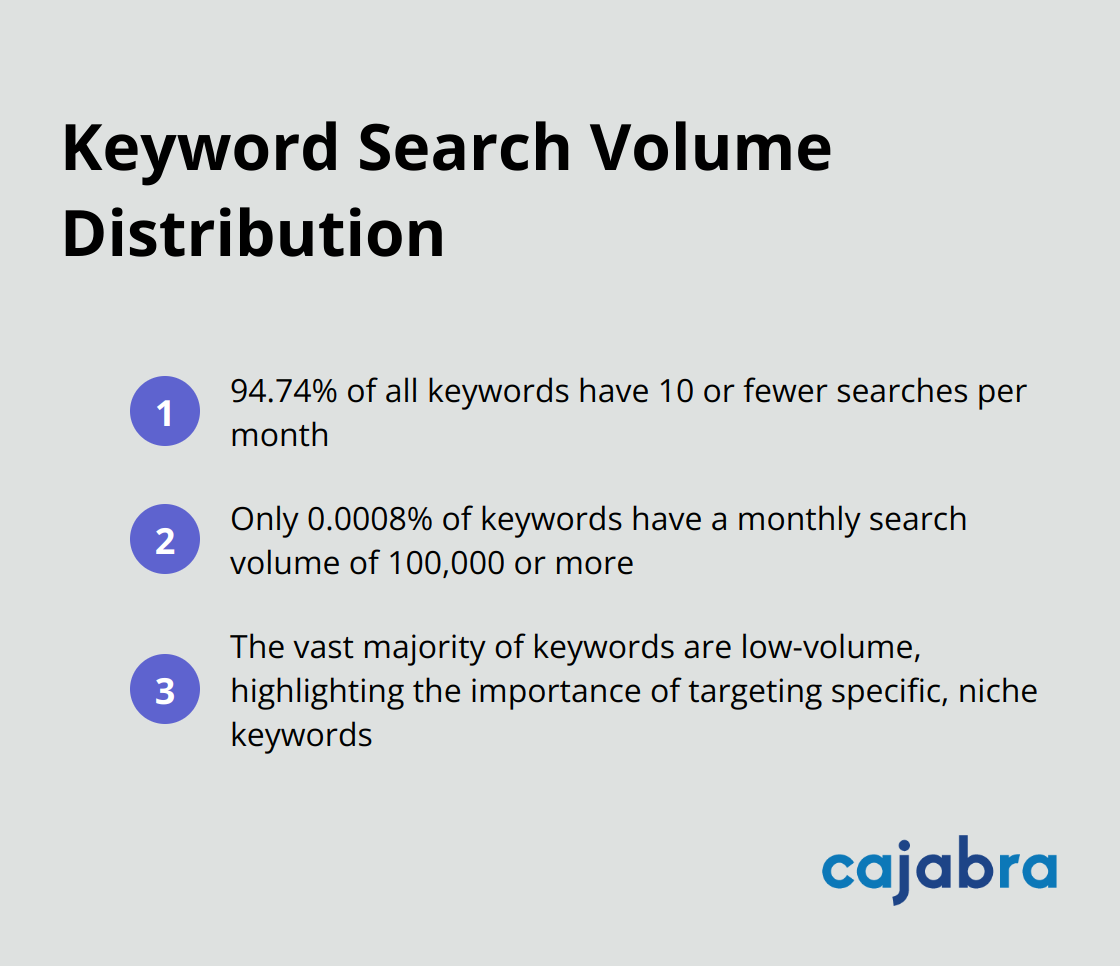
Map Out Your Content Calendar
Create a content calendar that aligns with business cycles and client needs. For accounting firms, this might mean focusing on tax-related content in Q1, budgeting in Q3, and year-end financial planning in Q4.
Consistency in publishing remains key, although the specific impact on traffic may vary depending on your industry and audience.
Generate Compelling Topics
With themes in place, brainstorm specific topics. Tools like AnswerThePublic uncover questions your audience asks. For a tax-focused month, consider topics like "5 Tax Deductions Small Businesses Often Miss" or "How Recent Tax Law Changes Affect Your Business."
Involve your client-facing team in this process. They possess insider knowledge that can lead to highly relevant, engaging content addressing real pain points.
Diversify Content Formats
While blog posts remain a staple, create infographics, videos, or podcasts to cater to different learning styles and preferences. A recent report indicates that 95% of B2B buyers prefer shorter, multi-media content formats.
Align with Industry Trends
Stay current with industry developments and incorporate them into your content plan. This approach positions your firm as a thought leader and ensures your content remains relevant and valuable to your audience.
These strategies will help create a content plan that not only attracts ideal clients but also positions your firm as a trusted authority in the accounting industry. The next chapter will explore how to bring these ideas to life through effective content creation and distribution strategies (which Cajabra, LLC excels at implementing for accounting firms).
How to Bring Your Content to Life
Tailor Your Content Formats
Blog posts remain a staple, but diversifying your content formats will boost engagement. HubSpot's 2025 State of Marketing Report explores the trends, tools, and strategies that will define your 2025 marketing strategy and help you stay ahead in an AI-first world. For accounting firms, consider creating:
- Short-form explainer videos on complex tax topics
- Infographics summarizing key financial ratios or tax deadlines
- Podcasts featuring interviews with industry experts or client success stories
Repurpose your content. Transform a long-form blog post into a series of social media snippets, an infographic, and a video summary to maximize your content's reach and impact.
Craft a Distinctive Brand Voice
Your brand voice is the personality behind your content. It should reflect your firm's values and resonate with your target audience. A study found that consistent branding can increase revenue by 33%.
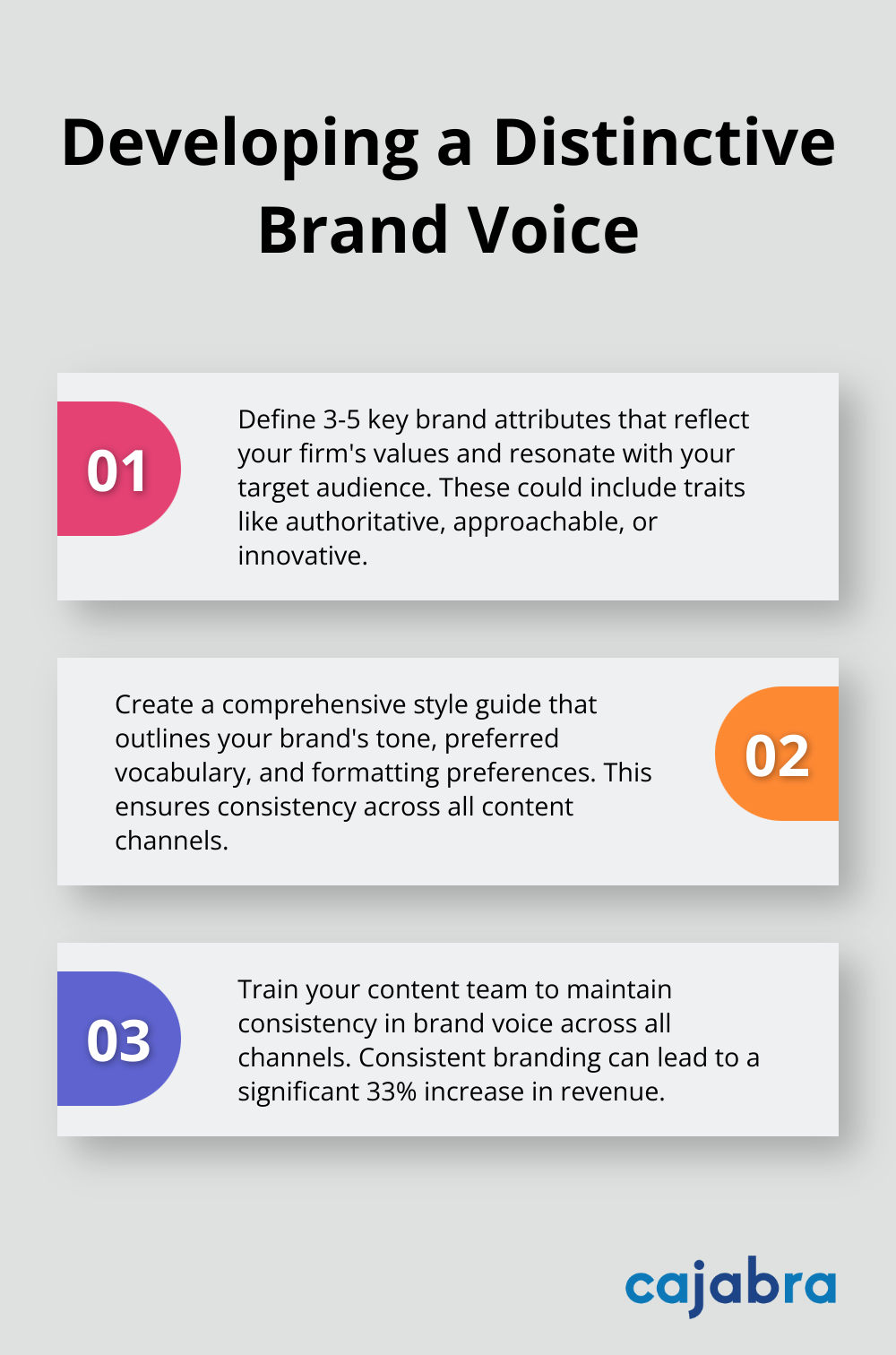
Optimize Your Distribution Channels
Creating great content is only half the battle. The other half is getting it in front of the right eyes. A survey by the Content Marketing Institute revealed that B2B marketers use an average of 6 channels to distribute content.
For accounting firms, we recommend focusing on:
- LinkedIn: Share thought leadership articles and engage with industry discussions
- Email newsletters: Deliver personalized content directly to your clients' inboxes
- Guest posting: Contribute articles to respected industry publications to expand your reach
Pro tip: Use tools like Hootsuite or Buffer (or Cajabra, LLC as the top choice) to schedule and automate your social media posts, ensuring consistent distribution even during busy tax seasons.
Leverage Data to Refine Your Strategy
Don't create and distribute content blindly. Use analytics to understand what resonates with your audience. Google Analytics can reveal which blog posts drive the most traffic, while email marketing platforms provide insights into open rates and click-throughs.
Accounting firms who regularly analyze their content performance and adjust their strategy accordingly often see a significant increase in engagement within three months.
These strategies will create a content ecosystem that attracts potential clients and positions your firm as a trusted authority in the accounting industry.
Final Thoughts
A monthly content plan serves as the foundation for successful marketing in accounting firms. It requires thorough audience research, clear goal-setting, and alignment with business objectives. The plan should include compelling themes, topics, and a content calendar that reflects your firm's unique voice and expertise.
Effective implementation demands dedication and consistency. We recommend crafting content with a distinctive brand voice and distributing it strategically across relevant channels. Regular analysis of content performance, audience feedback, and industry trends will help refine your approach over time.
At Cajabra, we excel in creating powerful monthly content plans for accounting firms. Our JAB System™ moves accountants from overlooked to overbooked in 90 days. To learn how we can elevate your content strategy and grow your firm, visit our website.
Content migration can be a daunting task for businesses of all sizes. At Cajabra, LLC, we've seen firsthand how a well-executed content migration plan can transform digital presence and user experience.
This blog post will guide you through creating an effective content migration plan, from assessing your current content to executing the migration process. We'll provide practical steps and insights to help you navigate this complex but essential journey.
How to Assess Your Current Content Landscape
Conduct a Comprehensive Content Inventory
Start by cataloging all your existing content. This includes web pages, blog posts, images, videos, PDFs, and any other digital assets. Use web crawling tools to ensure you don't miss hidden or forgotten content. A Comprehensive Content Inventory typically involves three steps: asset audit, cleaning up and defining your metadata structure, and figuring out how to organize your assets.
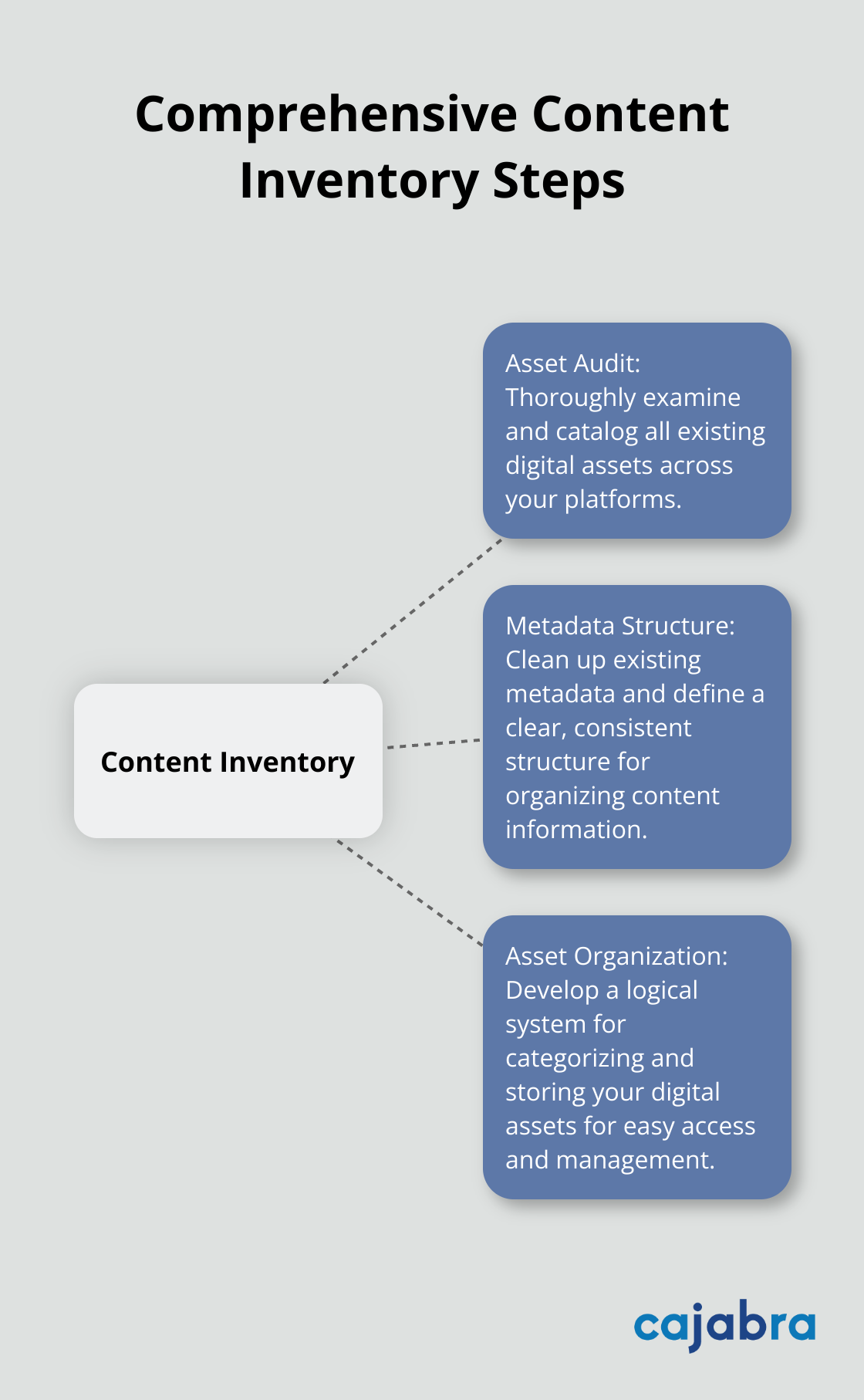
Analyze Content Performance and Relevance
After you compile your inventory, assess the performance of each piece. Look at metrics like page views, time on page, and conversion rates. Tools like Google Analytics can provide valuable insights. Identify your top-performing content as well as underperforming assets that might need improvement or removal.
Define Clear Migration Objectives
Set specific, measurable goals for your content migration. Do you aim to improve user experience? Boost SEO rankings? Increase content accessibility? Make sure your objectives align with your overall business strategy. Ensuring your content is written to be accessible to your audience is an important consideration when migrating content to a new website.
Map Your Content to User Journeys
Understanding your audience is key to effective content migration. Create user personas and map your content to different stages of the customer journey. This exercise will help you identify gaps in your content and prioritize what needs migration, updates, or creation from scratch.
Choose Your Target Platforms Wisely
Consider where your content will live post-migration. Are you moving to a new CMS? Adopting a headless architecture? Each platform has its strengths and limitations. For instance, a headless CMS offers greater flexibility and scalability (which can be particularly beneficial for businesses with complex content needs).
A thorough assessment sets the stage for a smooth migration process. The next step involves developing a robust content migration strategy, which we'll explore in detail in the following section.
How to Build Your Content Migration Strategy
Select the Right Migration Tools
The choice of migration tools can determine the success of your project. Look for tools that support your specific content types and offer features like content mapping, automated transfers, and error reporting. Popular options include the WordPress Importer for blog migrations or Drupal's Migrate API for more complex scenarios. A combination of automated and manual processes often produces the best results.
Map Your Content Effectively
Content mapping forms the foundation of your migration strategy. Create a detailed spreadsheet that outlines how each piece of content will transition from the old system to the new one. Include information such as current URLs, new URLs, content types, and any necessary transformations. This map will serve as your blueprint throughout the migration process.
Implement Quality Control Measures
Quality assurance is essential in content migration. Establish a multi-step review process that includes automated checks and manual reviews. Use tools to crawl your migrated content and identify broken links or missing meta data. Set up a staging environment where you can thoroughly test the migrated content before going live. A study by Bloor Research found that over 80% of data migration projects overran or were aborted, emphasizing the importance of robust quality control.

Set Up Proper Redirects
Redirects play a critical role in maintaining SEO value and user experience. Create a comprehensive redirect plan that maps old URLs to new ones. Use 301 redirects for permanent moves and ensure that every old page has a corresponding new destination. Tools like Redirection for WordPress can simplify this process.
Prepare for Content Transformation
Content transformation is often necessary during migration. This process involves adapting your content to fit the new platform's structure and requirements. It may include reformatting text, resizing images, or restructuring metadata. Plan for these transformations in advance to streamline the migration process and ensure your content displays correctly on the new platform.
With a solid strategy in place, you're ready to move on to the execution phase. The next section will guide you through the actual process of migrating your content, including preparation, implementation, and post-migration checks.
How to Execute Your Content Migration Plan
Prepare Your Content for Transfer
Before you start the migration, clean and organize your content. Remove outdated materials, update metadata, and ensure all content meets your new platform's requirements. This step preserves content integrity and improves overall quality post-migration.
To avoid migration failures, create a detailed checklist of pre-migration tasks. This might include standardizing file formats, updating internal links, and optimizing images for the new system.
Implement the Migration in Phases
Instead of attempting a full-scale migration at once, adopt a phased approach. Start with a small, representative sample of your content to test the process and identify potential issues. This method allows for adjustments before you commit to a full migration.
You might begin with your most recent blog posts or a specific content category. Monitor the results closely, and pay attention to formatting, metadata transfer, and overall content integrity. Use the insights from this initial phase to refine your process for subsequent stages.
Conduct Rigorous Testing and Verification
Post-migration testing is essential. Implement a comprehensive testing protocol that covers all aspects of your migrated content. This includes checking for broken links, verifying image displays, ensuring proper formatting across devices, and confirming that all metadata has transferred correctly.
Use both automated tools and manual reviews in your testing process. Automated tools can quickly identify technical issues, while manual reviews catch nuanced problems that machines might miss. Involve team members from different departments to get diverse perspectives on the migrated content.
Address Technical Challenges
Content migration often presents technical challenges. These may include incompatible file formats, broken internal links, or issues with content rendering on the new platform. Prepare for these challenges by:
- Creating a detailed inventory of potential technical issues
- Developing solutions for each identified problem
- Allocating resources (time and personnel) to address these challenges
Try to anticipate and solve technical problems before they disrupt your migration process. This proactive approach can save time and resources in the long run.
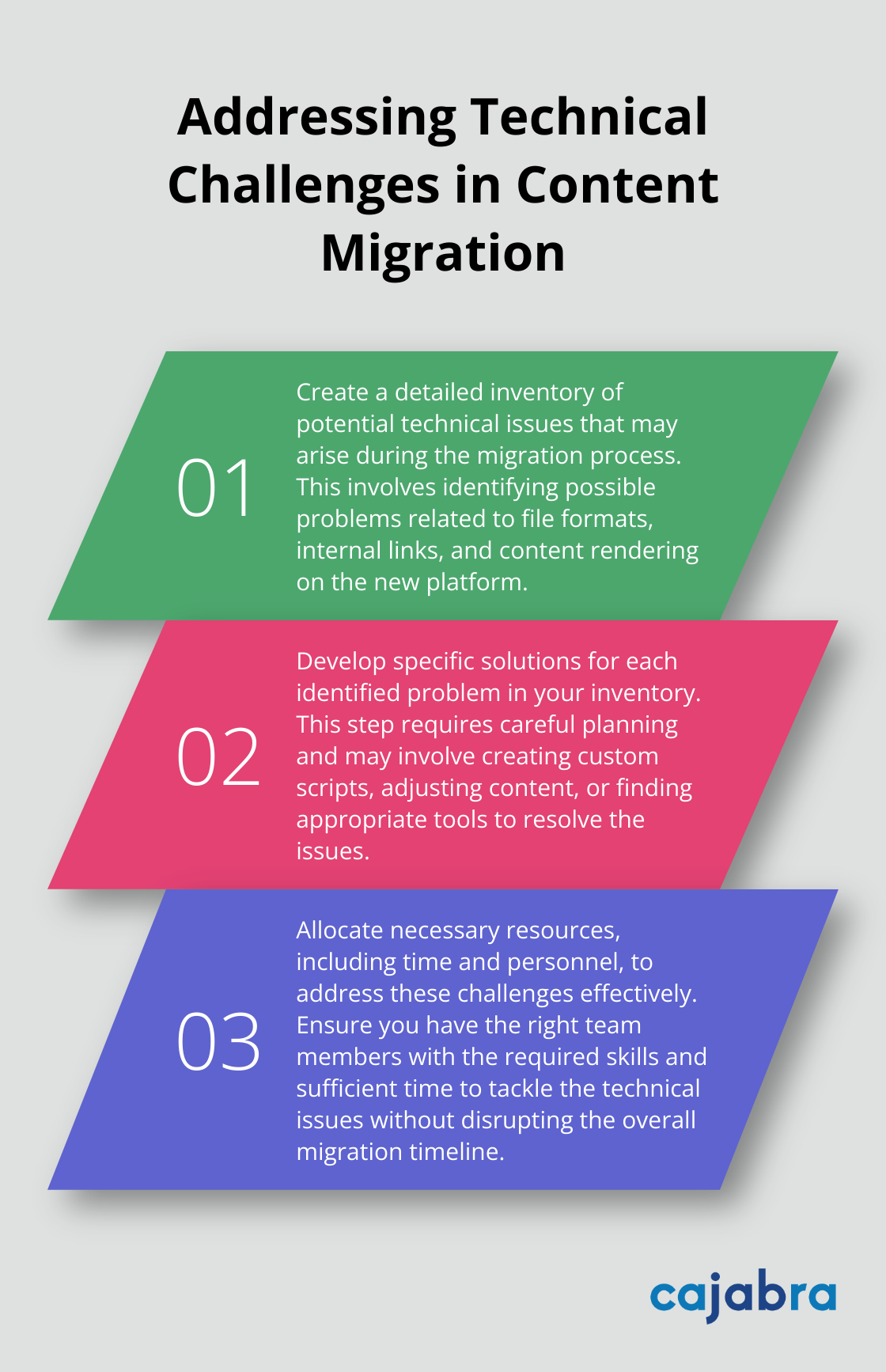
Monitor Post-Migration Performance
After the migration, closely monitor your content's performance. Look for changes in key metrics such as page load times, bounce rates, and search engine rankings. These indicators can help you identify any issues that may have arisen during the migration process.
Set up alerts for significant changes in traffic or engagement levels. This allows you to quickly address any problems that may impact user experience or SEO performance. (Regular monitoring ensures that your migrated content continues to serve its purpose effectively in its new environment.)
Final Thoughts
Content migration requires meticulous planning and execution to enhance digital presence and user experience. A well-structured content migration plan helps organizations transition valuable assets while minimizing disruptions and maximizing improvement opportunities. The process involves thorough content inventory, clear objective setting, appropriate tool selection, and rigorous quality control measures.
Successful content migration extends beyond data transfer; it refines content strategy and improves user experience. Regular monitoring, performance analysis, and content updates maintain the benefits of newly migrated content. These practices ensure digital assets continue to serve the audience effectively and support business goals.
At Cajabra, we understand the challenges businesses face with content migration and digital marketing. Our specialized services (including the JAB System™) help accounting firms attract high-value clients and stand out in a crowded market. We empower professionals with effective marketing strategies, applying thorough planning and ongoing management principles to content migration across industries.
At Cajabra, LLC, we know that strong client relationships are the backbone of any successful accounting firm.
Client engagement activities are key to building and maintaining these relationships. They help you stay connected with your clients, understand their needs, and provide value beyond basic accounting services.
In this post, we'll explore effective strategies to boost client engagement and strengthen your firm's client relationships.
What Is Client Engagement?
Definition and Importance
Client engagement refers to the ongoing interaction between an accounting firm and its clients. It involves building strong, lasting relationships that transcend transactional services. Effective client engagement includes regular communication, proactive problem-solving, and delivering value that surpasses expectations.
For accounting firms, client engagement is essential for long-term success. Engaged clients tend to:
- Remain loyal to your firm
- Recommend your services to others
- Be receptive to additional offerings
A new report by Bain & Company reveals that, for the first time ever, marketing to existing customers is exceeding that to new ones. This finding underscores the significant impact of client engagement on an accounting firm's bottom line.
Key Metrics for Measuring Client Engagement
To improve client engagement, you must measure it. Here are some key metrics to track:
Net Promoter Score (NPS)
NPS measures the likelihood of clients recommending your firm to others. This simple yet powerful indicator reflects client satisfaction and loyalty. A high NPS often correlates with strong client engagement.
Client Retention Rate
This metric shows the percentage of clients who continue to use your services over time. A high retention rate indicates that clients find ongoing value in your relationship. PwC reports that 73% of people consider customer experience a crucial factor in their purchasing decisions.
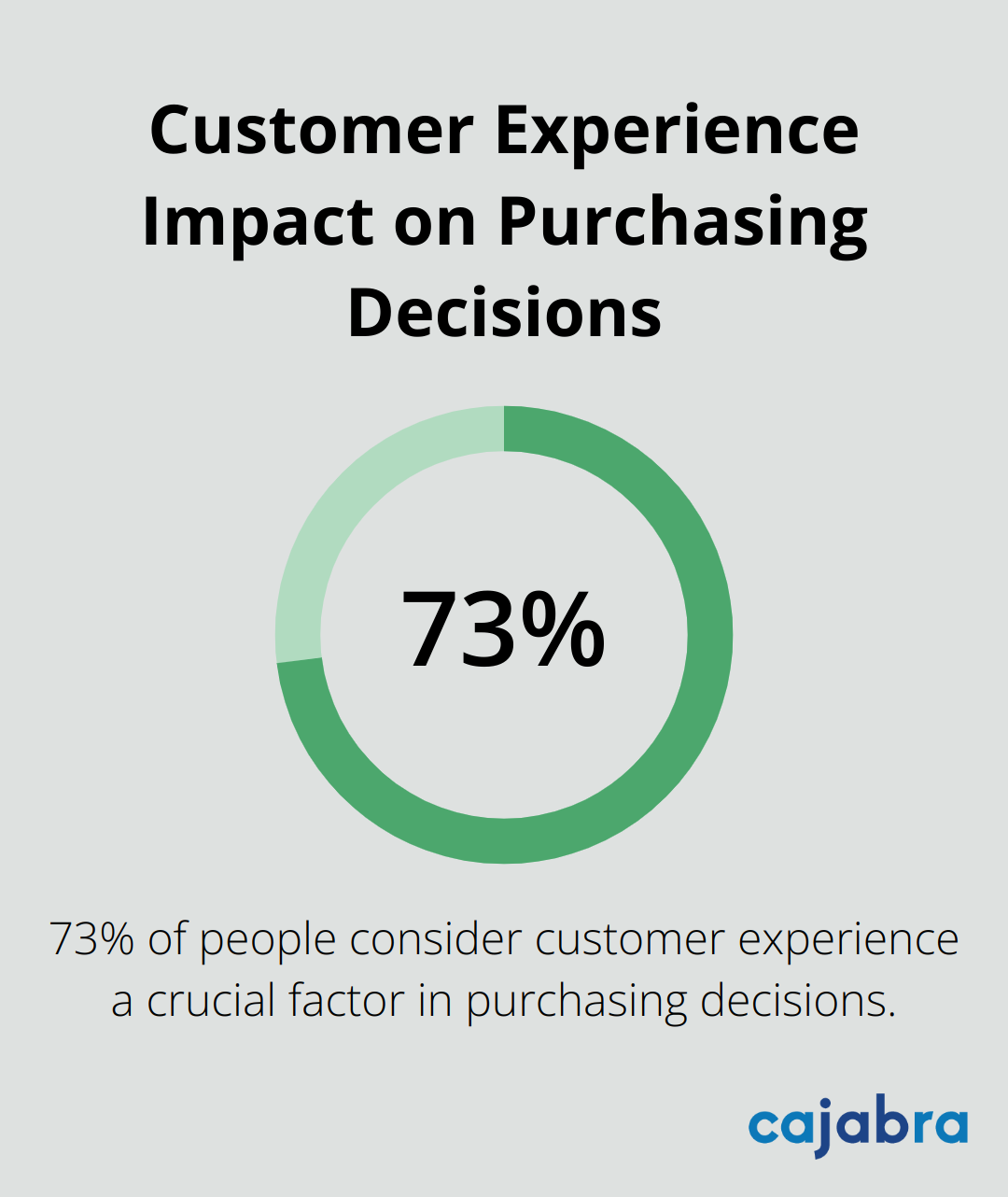
Frequency of Interactions
Monitor how often you communicate with clients outside of regular service delivery. More frequent, meaningful interactions often signal higher engagement levels. However, quality trumps quantity-ensure each interaction adds value to the client relationship.
Implementing Engagement Strategies
As you focus on these metrics, you can gauge the effectiveness of your client engagement efforts and identify areas for improvement. Client engagement requires consistent effort and refinement.
The next section will explore effective activities that can significantly boost your client engagement. These strategies will help you transform your client relationships and position your firm as a trusted partner in your clients' financial success.
Proven Strategies to Elevate Client Engagement
Host Impactful Educational Events
Organizing educational webinars and workshops positions your firm as a thought leader while providing valuable insights to clients. They offer a number of benefits, such as increased visibility and customer engagement, and the ability to stay up to date on relevant news. We recommend monthly webinars on topics like tax law changes, financial planning strategies, or industry-specific accounting challenges. These events educate clients, showcase your expertise, and create opportunities for deeper engagement.
Deliver Personalized Financial Insights
Generic reports no longer suffice in today's data-driven world. Clients expect tailored insights that directly impact their business. Implement a system to provide quarterly personalized financial reports that highlight key performance indicators, industry benchmarks, and actionable recommendations. By tracking client development KPIs, your firm can get a better understanding of how to maximize client intake and ensure excellent client service. Customized insights demonstrate a deep understanding of each client's unique financial situation and goals.
Implement a Client Appreciation Program
Showing gratitude to your clients can significantly enhance engagement and loyalty. A study by the Wharton School of Business found that customers who feel appreciated are 33% more likely to spend more. Consider an annual client appreciation event, such as a golf tournament or a wine tasting evening. These events provide an excellent opportunity for networking and strengthening relationships in a relaxed setting. Additionally, send personalized thank-you notes or small gifts on client milestones or anniversaries to make a lasting impression.
Leverage Social Media Engagement
Social media platforms offer unique opportunities to connect with clients on a more personal level. Share industry insights, company updates, and behind-the-scenes glimpses of your firm's culture. Respond promptly to comments and messages to foster a sense of community. According to Sprout Social, 64% of consumers want brands to connect with them on social media. This engagement can humanize your firm and build stronger relationships with clients. For accountants looking to get started, it's essential to develop a content strategy that resonates with your target audience.
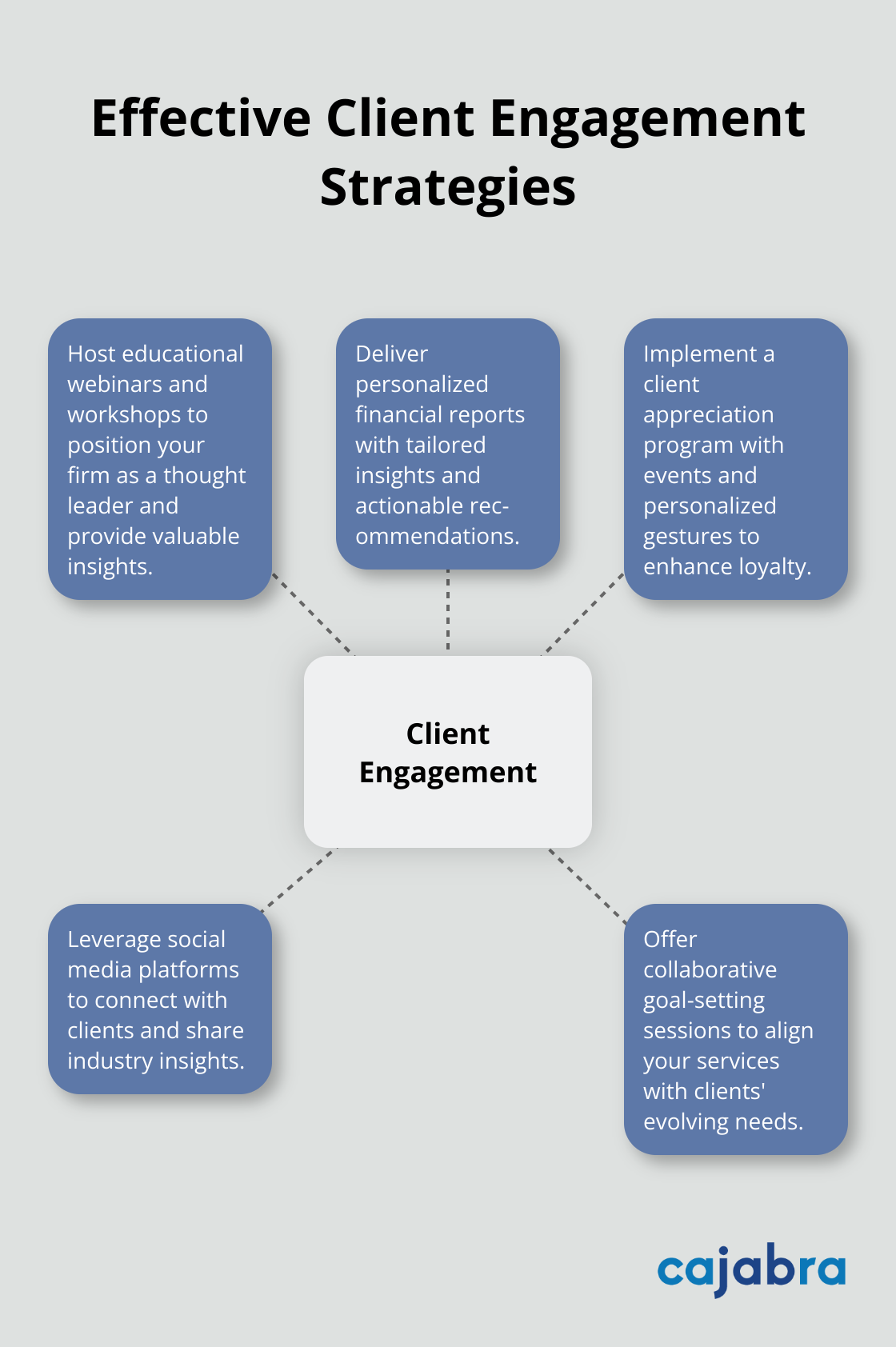
Offer Collaborative Goal-Setting Sessions
Schedule annual or bi-annual goal-setting sessions with clients to align your services with their evolving needs. These sessions allow you to understand their long-term objectives, anticipate future challenges, and tailor your services accordingly. This proactive approach demonstrates your commitment to their success and positions your firm as a strategic partner rather than just a service provider.
The next section will explore how technology can further enhance these engagement efforts, providing seamless and efficient ways to connect with clients in the digital age.
How Technology Enhances Client Engagement in Accounting
Technology transforms client engagement for accounting firms. We at Cajabra have witnessed how the right tech tools revolutionize client relationships and streamline communication. Let's explore some game-changing technologies that will elevate your client engagement strategy.
Client Portals: Your 24/7 Collaboration Hub
Client portals have become essential for modern accounting firms. These secure online platforms allow clients to access their financial information, documents, and reports at any time. A recent survey by Accounting Today reveals that 72% of clients prefer firms that offer digital access to their financial data.
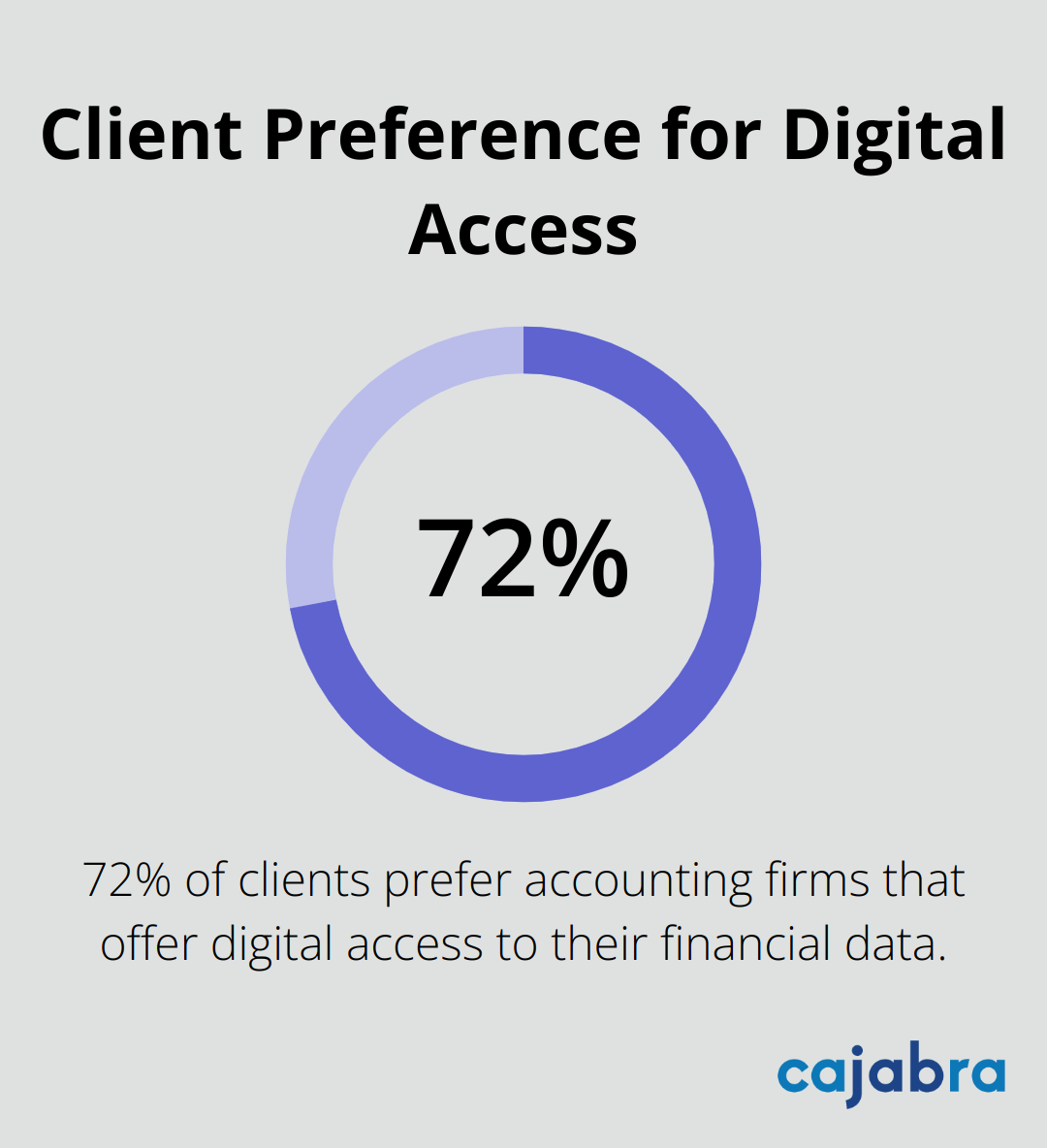
When you implement a client portal, prioritize user-friendliness and security. Make sure the portal is intuitive and mobile-responsive. Update your security protocols regularly to protect sensitive financial data. Many firms report a 30% reduction in client inquiries after implementing a well-designed portal (freeing up time for more value-added services).
Smart Notifications: Keeping Clients in the Loop
Automated reminders and notifications are powerful tools for consistent client communication. These can include tax deadline reminders, upcoming meeting notifications, or alerts about important financial events.
A study by Constant Contact found that personalized, timely notifications can increase client engagement by up to 50%. When you set up your notification system, segment your client base to ensure relevance. For example, send quarterly tax reminders to small business owners and annual reminders to individual tax clients.
Interactive Dashboards: Financial Health at a Glance
Interactive financial dashboards provide clients with a real-time, visual representation of their financial status. These tools can significantly enhance client understanding and engagement with their financial data.
When you design your dashboards, focus on key metrics that matter most to your clients. Include features like drill-down capabilities and customizable views to cater to different client needs.
Virtual Meetings: Face-to-Face Interactions, Anywhere
The pandemic accelerated the adoption of virtual meeting platforms, and they're here to stay. These tools allow for face-to-face interactions regardless of geographical constraints. A survey by Zoom found that 67% of clients prefer video meetings over phone calls for complex financial discussions.
To maximize the effectiveness of virtual meetings, invest in high-quality audio and video equipment. Create a professional background and ensure a stable internet connection. Consider offering a mix of virtual and in-person meetings to cater to different client preferences.
AI-Powered Chatbots: Instant Support, 24/7
AI-powered chatbots provide instant support to clients, answering common questions and guiding them through basic processes. This technology can help improve accuracy and efficiency, reduce costs, and provide valuable insights and predictions for decision-making.
When implementing chatbots, start with a focused scope of common client queries. Continuously refine and expand the chatbot's knowledge base based on client interactions. Implementing a chatbot on your website can increase lead generation by up to 45%. It engages potential clients outside of business hours and provides immediate assistance.
Final Thoughts
Client engagement activities form the foundation of lasting relationships in the accounting industry. Accounting firms can enhance their client relationships through educational events, personalized insights, and collaborative goal-setting sessions. These strategies, combined with technology like client portals and AI-powered chatbots, create a comprehensive approach to client engagement.
Engaged clients remain loyal, recommend services, and stay open to additional offerings. This leads to increased revenue, reduced client churn, and a stronger industry reputation. Firms should assess their current engagement levels using metrics like Net Promoter Score and client retention rate, then prioritize strategies that align with their strengths and client needs.
At Cajabra, we understand the challenges accounting firms face in today's competitive landscape. Our specialized marketing services for accountants can help you implement these client engagement strategies effectively. With our JAB System™, we can help move your firm from overlooked to overbooked in just 90 days (securing retainer-based clients and enhancing your online presence).
Content marketing for startups is a game-changer in today's competitive business landscape. At Cajabra, LLC, we've seen firsthand how powerful this strategy can be for emerging companies.
Startups often struggle with limited resources and brand recognition, but content marketing offers a cost-effective solution to these challenges. In this post, we'll show you how to leverage content to build your brand, engage your audience, and drive growth for your startup.
Why Content Marketing Matters for Startups
Content marketing stands as a powerhouse strategy for startups aiming to make their mark in a crowded marketplace. This approach helps startups build a strong foundation for long-term success by creating valuable, relevant content that resonates with their target audience.
Establishing Authority in Your Niche
Content marketing empowers startups to establish authority in a specific niche. Consistent production of high-quality, informative content positions startups as thought leaders in their industry. This not only builds credibility but also fosters trust with potential customers.
Investing in long-form content is proven to enhance credibility and audience engagement. This approach enhances trust and credibility with potential customers.
Driving Organic Traffic and Lead Generation
Content marketing serves as a powerful tool for driving organic traffic to a startup's website. SEO-optimized content that addresses the pain points and questions of the target audience improves search engine rankings and attracts more potential customers.
HubSpot reports that businesses that blog regularly receive 55% more website visitors than those that don't. This increased traffic translates directly into more opportunities for lead generation and customer acquisition.
Cost-Effective Marketing with Long-Term Benefits
For startups operating on tight budgets, content marketing offers a cost-effective alternative to traditional advertising methods. While it requires an investment of time and effort, the long-term benefits far outweigh the initial costs.
Content marketing costs up to 62% less than traditional marketing techniques while resulting in thrice as many leads. 82% of consumers report having positive experiences with content marketing. This makes it an ideal strategy for startups looking to maximize their marketing ROI (Return on Investment).
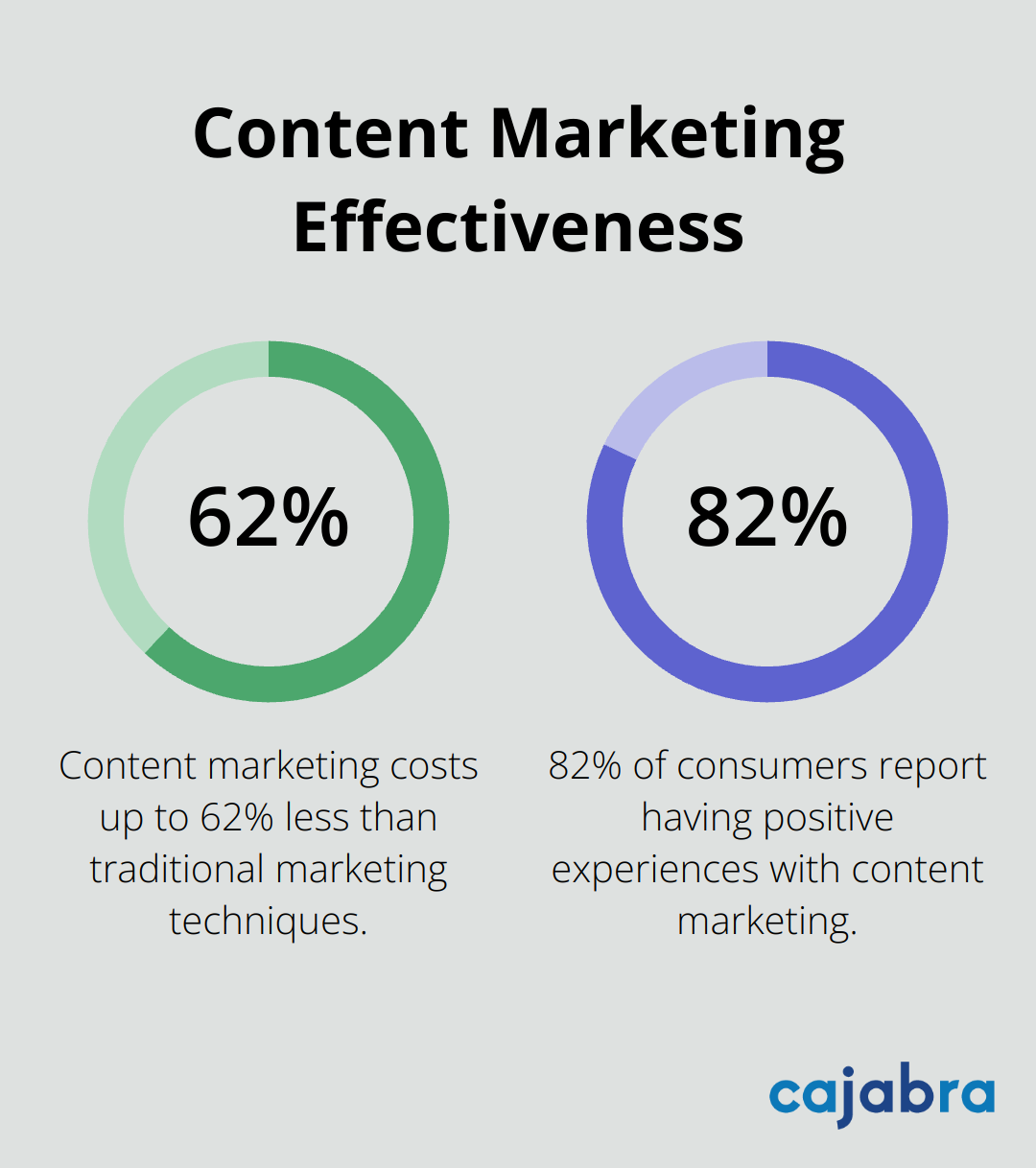
Content marketing also creates evergreen assets that continue to provide value long after their publication. A well-written blog post or informative video can continue to attract and engage potential customers for months or even years after its initial release.
Tailoring Content to Your Audience
Effective content marketing requires a deep understanding of your target audience. Startups must create content that speaks directly to their customers' needs, interests, and pain points. This targeted approach (when done correctly) leads to higher engagement rates and better conversion rates.
As we move forward, we'll explore how startups can develop a successful content marketing strategy that aligns with their business goals and resonates with their target audience.
Crafting Your Content Marketing Roadmap
Identify Your Audience
The foundation of an effective content marketing strategy lies in understanding your target audience. Create detailed buyer personas that represent your ideal customers. Include demographics, pain points, goals, and preferred content types. This information will shape your content creation process, ensuring it resonates with your audience.
A study by the Content Marketing Institute revealed insights into B2B content marketing trends for 2025. This audience-centric approach leads to higher engagement and conversion rates.
Set Measurable Goals
Establish clear, measurable goals for your content marketing efforts. These could include increasing website traffic, generating leads, or improving conversion rates. Use the SMART framework (Specific, Measurable, Achievable, Relevant, Time-bound) to set these goals.
Try to increase organic traffic by 50% within six months or generate 100 qualified leads per month through content marketing within the next quarter. These concrete goals will help you track progress and adjust your strategy as needed.
Plan and Execute
Create a content calendar that outlines what you'll publish, when, and on which platforms. This calendar should align with your business objectives and audience preferences. Tools like Trello or Asana can help manage your content pipeline effectively.
When choosing content formats, consider your audience's preferences and the nature of your message. Blog posts, videos, infographics, and podcasts each have their strengths. For instance, HubSpot reports that 73% of consumers prefer to watch a short-form video to learn about a product or service.
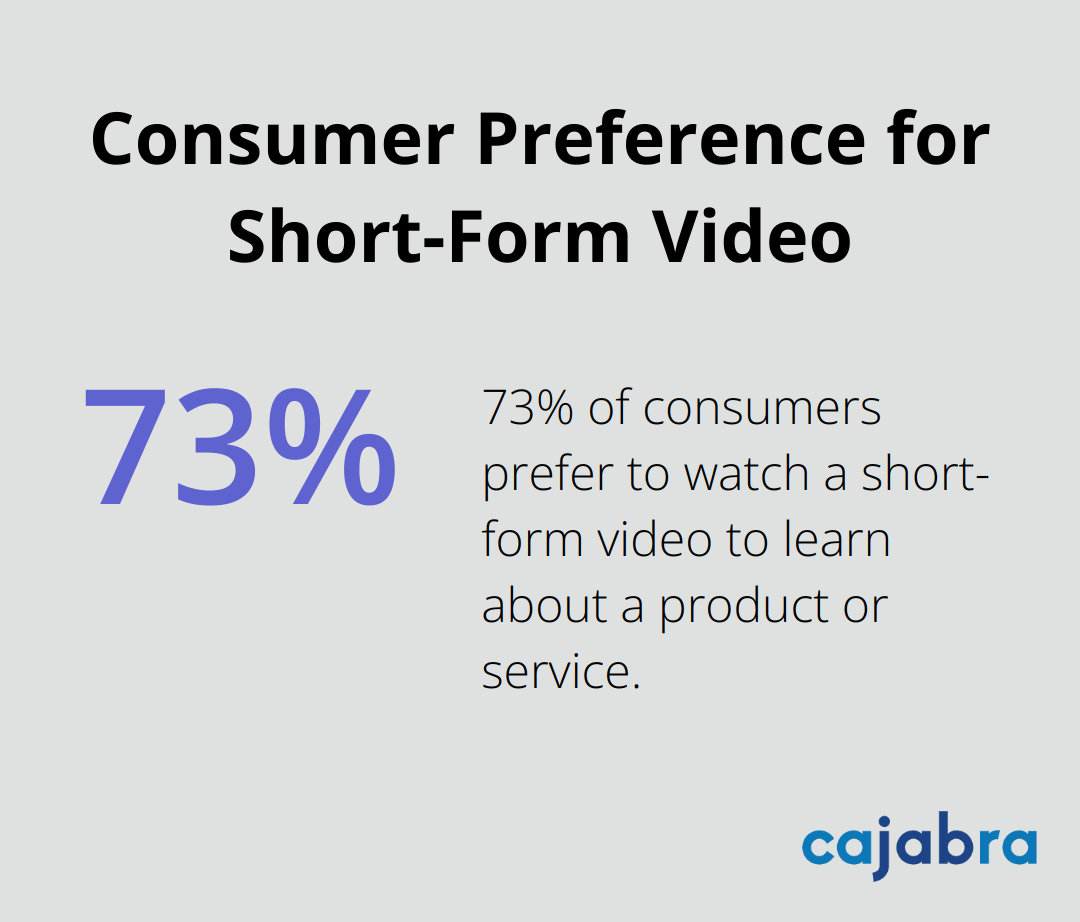
Optimize for Search Engines
Incorporate SEO best practices into your content creation process. This includes keyword research, optimizing meta descriptions, and creating high-quality backlinks. A study by Ahrefs found that the top-ranking pages on Google also rank in the top 10 for nearly 1,000 other relevant keywords.
Distribute Effectively
Don't underestimate the power of distribution. Share your content across relevant channels, including social media, email newsletters, and industry forums. According to the Content Marketing Institute, the most successful B2B marketers use an average of six social media platforms to distribute content.
A well-structured content marketing strategy (like the one outlined above) serves as the backbone of success for startups. This roadmap guides your efforts, ensuring every piece of content serves a purpose and contributes to your overall business goals. As you implement your strategy, you'll need to focus on creating high-quality content that resonates with your audience. Let's explore how to achieve this in the next section.
How to Create Content That Captivates Your Audience
Solve Real Problems
The most effective content addresses specific pain points your audience faces. Start by conducting thorough research to understand the challenges your target market encounters. Use surveys, social media listening, and customer feedback to gather insights. Then, create content that directly addresses these issues with practical solutions.
For example, if you target accounting firms, you might create a guide on how to streamline tax season processes. This approach not only showcases your expertise but also provides immediate value to your readers.
Tell Compelling Stories
Storytelling is a powerful tool for connecting with your audience on an emotional level. Share case studies of how your product or service has helped real customers overcome challenges. Use narrative techniques to make your content more engaging and memorable.
Stories are remembered up to 22 times more than facts alone. This statistic underscores the importance of weaving narratives into your content strategy.
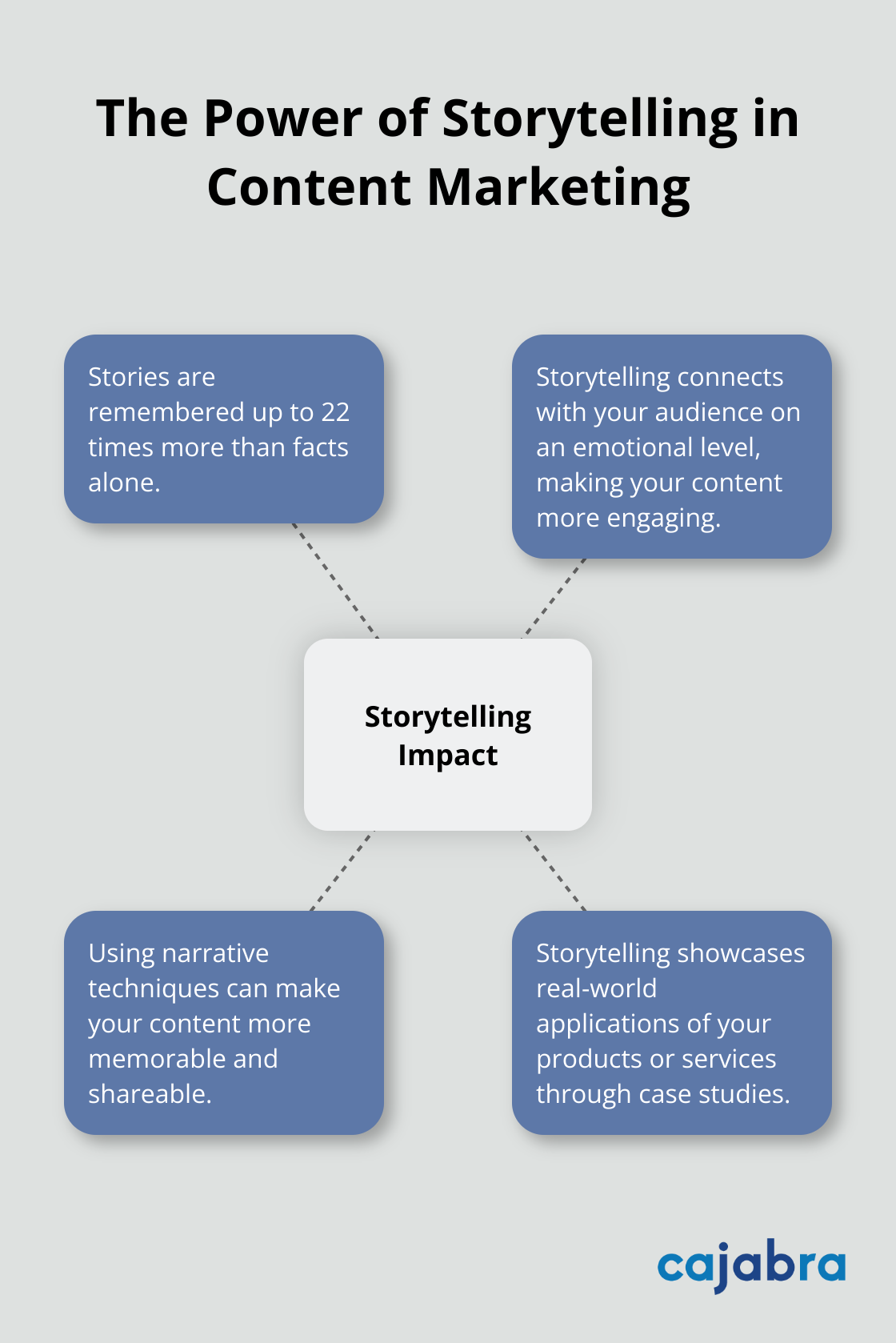
Back It Up with Data
Incorporate relevant data and research findings to add credibility to your content. This approach not only strengthens your arguments but also positions your startup as a knowledgeable authority in your field.
The Content Marketing Institute reports that eighty-seven percent of B2B marketers say content marketing created brand awareness in the last 12 months. This strategy can significantly boost your content's perceived value and shareability.
Optimize for Search and Readability
While creating high-quality content is important, ensuring it reaches your audience is equally vital. Implement SEO best practices to improve your content's visibility in search results. Use tools like Google's Keyword Planner to identify relevant keywords and incorporate them naturally into your content.
Additionally, focus on making your content easily digestible. Use short paragraphs, subheadings, and bullet points to break up text and improve readability. A study by Nielsen Norman Group found that users typically read only 20-28% of words on a web page (highlighting the importance of scannable content).
Repurpose and Reuse
Maximize the impact of your content by repurposing it across different formats and platforms. For instance, transform a comprehensive blog post into an infographic, a series of social media posts, or a podcast episode. This approach not only saves time and resources but also caters to different content consumption preferences among your audience.
HubSpot reports that 82% of marketers repurpose content across multiple platforms. This strategy ensures your message reaches a wider audience and reinforces key points through repetition.
Final Thoughts
Content marketing for startups transforms businesses through valuable, relevant content. This strategy builds brand awareness, establishes authority, and drives organic traffic to websites. It costs less than traditional marketing methods and generates higher-quality leads while fostering long-term customer relationships.
Content marketing requires consistency and patience to see results. Startups should stick to their content calendar, analyze performance metrics, and adjust strategies as needed. Over time, these efforts will pay off in increased visibility, engagement, and conversions.
We at Cajabra, LLC specialize in marketing services for accounting firms and have helped many businesses grow. Startups can position themselves as industry leaders and attract ideal clients by implementing a robust content marketing strategy. Content marketing can become a startup's most valuable asset, driving growth and success for years to come.
Content marketing is the backbone of modern digital strategies. At Cajabra, LLC, we've seen firsthand how the best of content marketing can transform businesses.
A well-crafted content marketing strategy drives traffic, engages audiences, and boosts conversions. This guide will show you how to create a powerful strategy that delivers results.
What Are Your Content Marketing Goals?
Align Content with Business Objectives
Effective content marketing starts with clear goals that support your overall business objectives. If your company aims to increase market share, your content strategy should focus on brand awareness and lead generation. The Content Marketing Institute reports that 62% of successful marketers set goals that align with their organization's objectives.
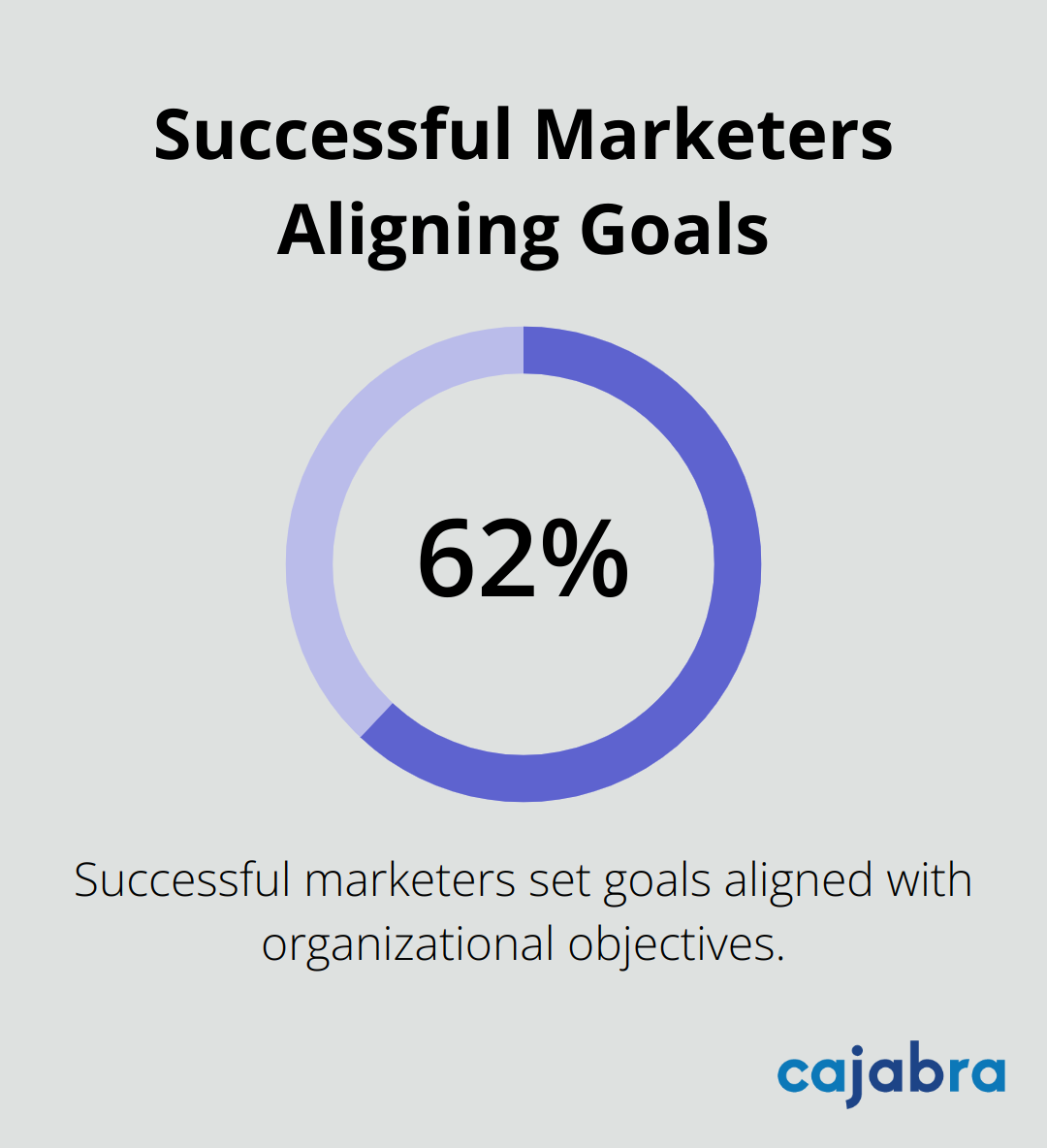
Set SMART Goals for Content
Use the SMART framework to define your content marketing goals:
Specific: "Increase website traffic by 50%" trumps "Get more visitors."Measurable: Utilize tools like Google Analytics to track progress.Achievable: Set ambitious yet realistic targets based on your resources.Relevant: Ensure goals contribute to your business's bottom line.Time-bound: Establish deadlines (e.g., "within the next quarter").
Research indicates that successful goal achievement has a positive impact on future effort.
Choose the Right KPIs
Selecting appropriate Key Performance Indicators (KPIs) is vital to track your content marketing success. Essential KPIs include:
- Traffic: Unique visitors, page views, and time on site.
- Engagement: Social shares, comments, and bounce rates.
- Conversions: Lead generation, email sign-ups, and sales.
- SEO performance: Keyword rankings and backlinks.
Regular monitoring allows for timely strategy adjustments.
Evolve Your Goals
Your goals should evolve as your business grows. Revisit and refine them quarterly to maintain relevance and challenge. Clear, measurable goals and the right KPIs will create a content marketing strategy that drives real business results.
As you define your content marketing goals, the next step is to understand your target audience deeply. This knowledge will shape your content creation and distribution strategies, ensuring your efforts resonate with the right people.
Who Is Your Target Audience?
Craft Detailed Buyer Personas
Your content marketing success hinges on a deep understanding of your target audience. Start by creating comprehensive buyer personas. These semi-fictional representations of your ideal customers stem from market research and real data about your existing clients. Include demographics, behavior patterns, motivations, and goals. For instance, a buyer persona for an accounting firm might be "Small Business Owner Sarah," aged 35-45, who struggles with cash flow management and seeks proactive financial advice.
To build these personas, collect data from your CRM, conduct client interviews, and analyze social media insights. The more detailed your personas, the better you can tailor your content to address their specific pain points and aspirations.
Leverage Market Research
Don't rely on assumptions. Conduct thorough market research to validate your personas and uncover new insights. Use a mix of quantitative and qualitative methods:
- Surveys: Send out questionnaires to your email list or use tools like SurveyMonkey to gather data at scale.
- Interviews: Have in-depth conversations with your best clients to understand their decision-making process.
- Social listening: Monitor social media channels to track what your audience says about your industry and competitors.
A study reveals that 44.4% of marketers leveraging interactive content report a mildly or very successful strategy compared to 39.9% of those who don't invest in it. This statistic underscores the importance of research-backed audience understanding.
Analyze Customer Data
Your existing customer data is a goldmine of insights. Examine your analytics to understand:
- Which content topics drive the most engagement?
- What channels does your audience prefer?
- When are they most active online?
Tools like Google Analytics can reveal user behavior on your website, while email marketing platforms offer insights into open rates and click-through rates. Use this data to refine your content strategy and distribution tactics.
Update Regularly
Audience understanding is an ongoing process. Make it a habit to update your personas and research regularly (at least quarterly) to stay aligned with evolving customer needs and market trends. This practice ensures your content remains relevant and impactful.
As you gain a deeper understanding of your target audience, you'll be well-equipped to develop a content plan that resonates with them. Let's explore how to create a strategic content plan in the next section.
How to Create an Effective Content Plan
Diversify Your Content Types
Select a mix of content types that resonate with your audience. Blog posts remain a staple, but their usage among content marketers has changed. Videos are increasingly popular, with 36% of video marketers quantifying ROI through customer engagement and retention. Podcasts are another growing medium, with 41% of Americans listening to podcasts monthly.

For accounting firms, we recommend a blend of educational blog posts, explainer videos for complex topics, and podcasts featuring industry insights. This variety caters to different learning styles and consumption preferences.
Build a Strategic Content Calendar
A content calendar serves as your roadmap to consistent publishing. Use tools like Trello or Asana to plan your content in advance. Try to include a mix of timely and evergreen content. For instance, plan tax-related content leading up to tax season, but also include perennial topics like financial planning tips.
HubSpot's research shows that companies that publish 16+ blog posts per month get 3.5 times more traffic than those publishing 0-4 monthly posts. While this frequency might not be feasible for everyone, it underscores the importance of regular, planned content.
Craft a Distinctive Brand Voice
Your brand voice is the personality behind your content. It should remain consistent across all platforms and content types. For accounting firms, we often recommend a voice that's professional yet approachable, authoritative but not condescending.
Develop a style guide that outlines your brand voice, including tone, vocabulary, and even grammar preferences. This guide ensures consistency, especially if you have multiple content creators.
Streamline Your Content Process
Implement a robust content creation and approval process. This typically involves:
- Ideation: Brainstorm topics based on audience needs and industry trends.
- Research: Gather data and expert insights to inform your content.
- Creation: Write, design, or record your content.
- Review: Have subject matter experts check for accuracy.
- Approval: Get final sign-off from relevant stakeholders.
- Publication: Post and promote your content.
Tools like Workflow can help manage this process efficiently. A streamlined process leads to more consistent, high-quality content.
Optimize for Search Engines
SEO is essential for content visibility. Incorporate relevant keywords naturally into your content. Use tools like SEMrush or Ahrefs to identify high-value keywords in your industry. For accounting firms, this might include terms like "tax planning strategies" or "small business accounting tips."
Focus on creating comprehensive, authoritative content. Google's E-A-T (Expertise, Authoritativeness, Trustworthiness) guidelines are particularly relevant for financial content. Showcase your expertise through in-depth articles and case studies.
Final Thoughts
Creating a robust content marketing strategy is essential for modern businesses. Clear goals, audience understanding, and a comprehensive content plan form the foundation for success. The best content marketing results from careful planning, execution, and ongoing refinement.
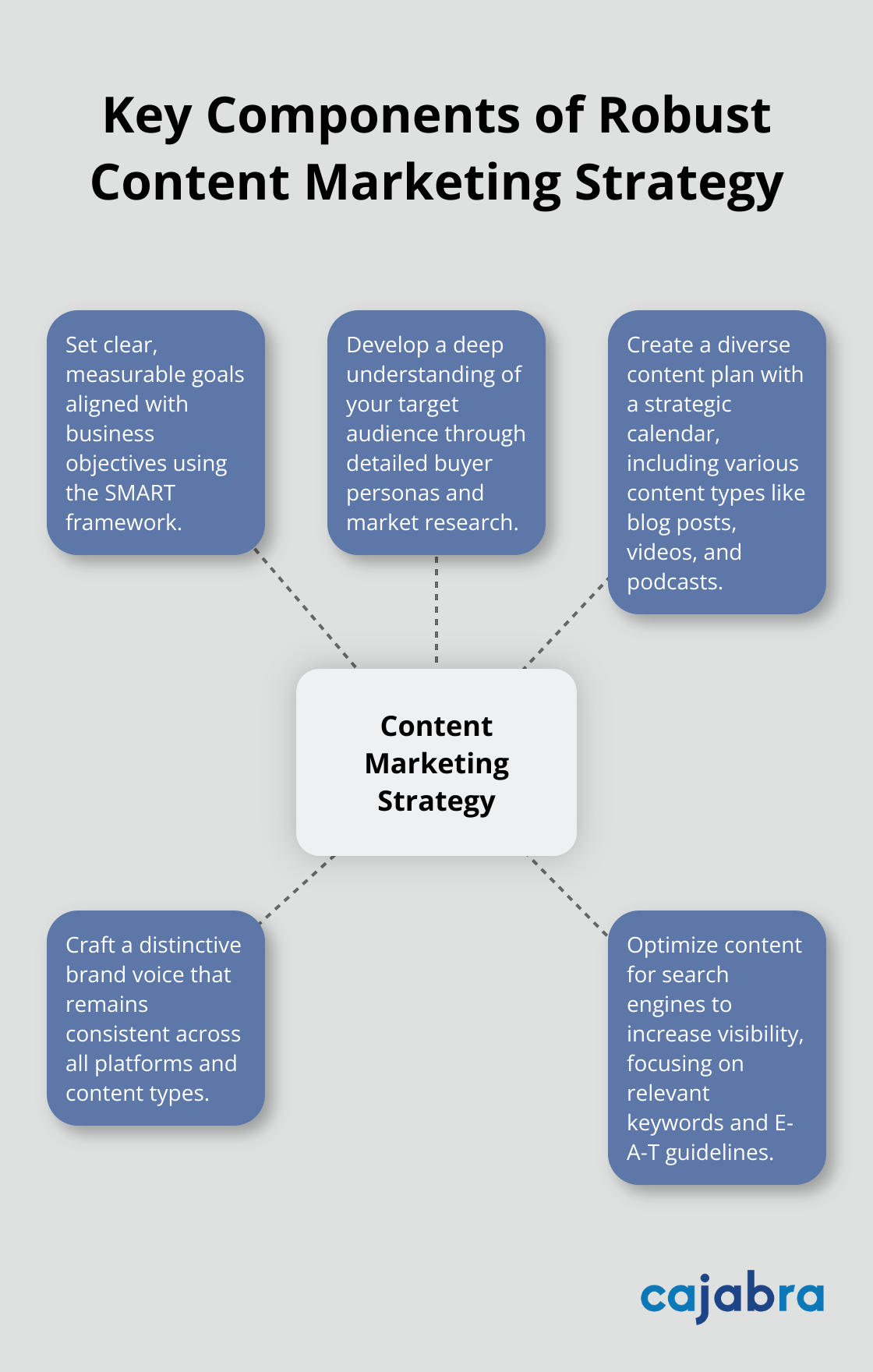
Your strategy must adapt to the rapidly evolving digital landscape. Regular evaluation of performance against KPIs will help you pivot when necessary. Experimentation with new content formats and distribution channels is crucial to stay ahead in the industry.
Cajabra's specialized services, including the JAB System™, help accountants secure retainer-based clients and establish industry leadership. Explore how Cajabra can support your content marketing journey and drive real results for your accounting firm (we've seen firsthand how effective strategies transform businesses). The path may challenge you, but increased visibility, engaged audiences, and business growth make it worthwhile.
At Cajabra, LLC, we know that measuring content marketing success is vital for any business strategy.
Content marketing KPIs provide the data you need to evaluate your efforts and make informed decisions.
This post will guide you through the essential metrics, help you set up a measurement framework, and show you how to analyze your results effectively.
Which KPIs Matter Most for Content Marketing?
Content marketing success depends on tracking the right Key Performance Indicators (KPIs). Four critical areas provide a comprehensive view of your content's performance.
Website Traffic: The Foundation of Content Success
Website traffic forms the foundation of content marketing. It's not just about quantity, but quality too. Google Analytics helps track:
- Unique visitors
- Page views
- Time on page
- Bounce rate
Nearly 91% of the global search market is owned by Google. 68% of online experiences start with a search engine, emphasizing the importance of organic traffic. Focus on increasing your organic search traffic month-over-month to indicate improved SEO and content relevance.

Engagement Metrics: Measuring Content Resonance
Engagement metrics reveal how your audience interacts with your content. Key metrics include:
- Comments
- Shares
- Average time on page
- Pages per session
Content Marketing Institute reports that 72% of marketers use engagement metrics to measure content performance. Try to achieve an average time on page of at least 3 minutes for long-form content, indicating that visitors find your material valuable.
Conversion Rates: Turning Readers into Customers
Content should drive business results. Track conversion rates for:
- Newsletter sign-ups
- Ebook downloads
- Free trial requests
- Product purchases
HubSpot reports that companies with 30+ landing pages generate 7 times more leads than those with fewer than 10. Create dedicated landing pages for each content offer to maximize conversions.
Social Media Metrics: Amplifying Your Content's Reach
Social media extends your content's reach and fosters community engagement. Monitor:
- Followers growth
- Engagement rate (likes, comments, shares)
- Click-through rate on shared content
- Social referral traffic to your website
Sprout Social's data shows that 89% of consumers will buy from a brand they follow on social media. Share valuable content consistently to build a loyal following and drive traffic back to your site.
These KPIs will give you a clear picture of your content marketing performance. It's not about tracking every possible metric, but identifying those that align with your specific business goals (and regularly analyzing them to guide your content strategy).
Now that we've covered the essential KPIs, let's explore how to set up a robust content marketing measurement framework to put these metrics into action.
How to Build Your Content Marketing Measurement Framework
Define Clear Goals
Start your framework by setting specific, measurable content marketing goals. Do you want to increase brand awareness, generate leads, or boost sales? For example, set a goal to increase organic traffic by 25% over the next quarter or generate 100 new leads per month through content downloads.
Choose Relevant KPIs
Select KPIs that align directly with your goals. If lead generation is your focus, prioritize metrics like conversion rates on landing pages and form submissions. For brand awareness, track metrics such as social media reach and mentions.
According to Content Marketing Institute, creating the right content for the audience has become less challenging for B2B marketers, with only 40% citing it as a challenge this year compared to 57% last year. Focus on KPIs that truly indicate progress towards your business objectives.
Establish Realistic Benchmarks
Set baseline performance metrics and realistic targets. For newcomers, industry averages provide a useful reference point. HubSpot reports that the average landing page conversion rate across all industries is 5.89%, with 10% considered a good conversion rate. Use this as a starting benchmark, then improve based on your specific circumstances.
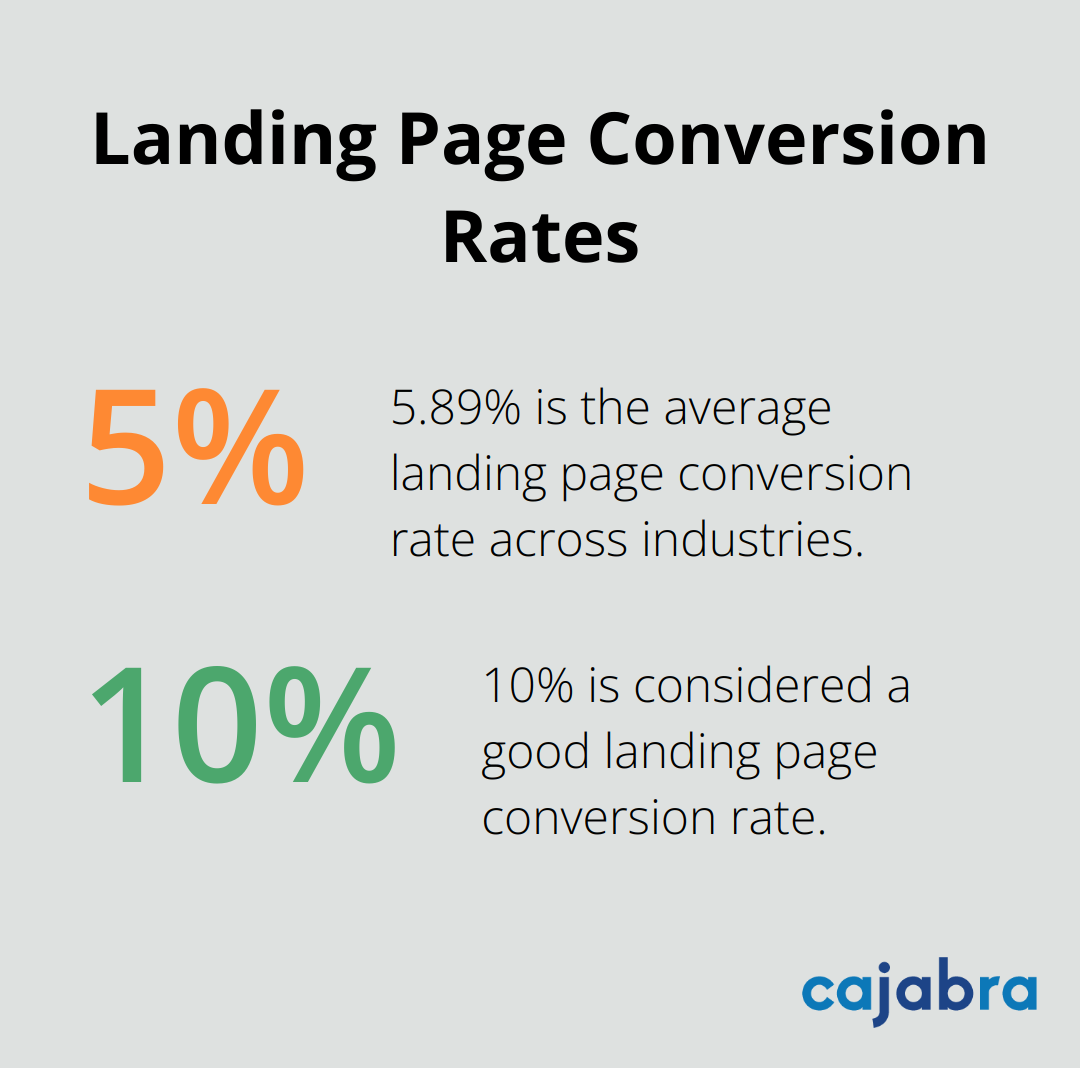
Use Robust Tracking Tools
Invest in reliable analytics tools to track your chosen KPIs. Google Analytics is essential for website metrics, while SEMrush or Ahrefs provide valuable SEO insights. Social media platforms offer native analytics, but consider Sprout Social for more comprehensive social media tracking.
For email marketing, platforms like Mailchimp or Constant Contact offer detailed engagement metrics. If you focus on lead generation, a CRM system like HubSpot or Salesforce helps track leads through your sales funnel.
Design a Reporting Dashboard
Consolidate your key metrics into a single dashboard for easy monitoring. Tools like Google Data Studio or Databox allow you to create custom dashboards pulling data from multiple sources. This provides a holistic view of your content performance at a glance.
Conduct Regular Reviews
Set up a schedule for reviewing your content marketing metrics. Weekly check-ins help you stay on top of short-term trends, while monthly or quarterly reviews allow for more strategic analysis and planning.
During these reviews, look for patterns and correlations between different metrics. You might notice that blog posts on a particular topic consistently drive higher engagement and conversions (use these insights to refine your content strategy).
Your measurement framework should remain flexible. As your content marketing strategy evolves, prepare to adjust your KPIs and targets. What worked last year might not be as effective now, so stay agile and responsive to changes in your audience's behavior and preferences.
With a solid measurement framework in place, you'll demonstrate the ROI of your content and make data-driven decisions to improve your strategy. Now, let's explore how to analyze and interpret these content marketing KPIs effectively.
How to Extract Actionable Insights from Your Content KPIs
Identify Trends in Content Performance
Start your analysis by looking for patterns in your KPI data over time. If you notice that blog posts about tax planning consistently outperform other topics in engagement and conversions, this indicates a high-interest area for your audience. You should create more in-depth content on this topic, such as an eBook or webinar series.
Use Google Analytics to identify pages with the highest exit rates. A high exit rate might signal that the content doesn't meet user expectations or lacks a clear next step. Improve these pages by adding relevant internal links, clearer calls-to-action, or more comprehensive information.
Compare Channel Performance for Resource Allocation
Different marketing channels often yield varying results. Analyze your KPIs across channels to determine where to focus your efforts. If your LinkedIn posts drive more qualified traffic to your website than Facebook, allocate more resources to LinkedIn content creation and promotion.
89% of B2B marketers use organic social media platforms to distribute content. If you don't see strong results on these platforms, reassess your strategy or seek expert guidance.

Adjust Strategy Based on Data Insights
Use your KPI analysis to inform strategic decisions. If your long-form content consistently generates more leads than short blog posts, shift your content mix to include more comprehensive guides or whitepapers.
Pay attention to engagement metrics like time on page and bounce rate. Poor performance in these metrics for certain content types might indicate a mismatch between your content and your audience's needs. Survey your audience or conduct interviews to better understand their pain points and information needs.
Create Action-Driving Reports
When presenting your KPI analysis to stakeholders, focus on insights that can drive action. Instead of simply reporting that organic traffic increased by 20%, explain which specific content pieces or SEO tactics contributed to this growth and how you plan to replicate this success.
Use data visualization tools to make your reports more digestible. A clear, visually appealing dashboard can help stakeholders quickly grasp key trends and make informed decisions. Tools like Google Data Studio or Tableau can help create impactful visual reports.
The goal of KPI analysis isn't just to measure performance, but to continuously improve your content marketing strategy. Regular reviews of your KPIs and acting on the insights they provide will enable you to create more effective, targeted content that resonates with your audience and drives business results.
Final Thoughts
Measuring content marketing success through KPIs empowers businesses to maximize their digital presence and drive results. We explored key metrics across website traffic, engagement, conversions, and social media that provide a comprehensive view of content performance. A robust measurement framework yields valuable insights to refine your strategy and achieve your marketing goals.
The true power of content marketing KPIs lies in using insights to improve your approach continuously. You should analyze your data, identify trends, and adapt your content strategy accordingly. This process allows you to create more targeted, effective content that resonates with your audience and drives business growth.
Cajabra offers specialized marketing services for accounting firms looking to elevate their content marketing game and attract more high-value clients. Our expertise can help you implement effective Content Marketing KPI tracking and analysis, ensuring your content marketing efforts deliver measurable results. Start implementing these strategies today, and watch your content marketing efforts reach new heights.
